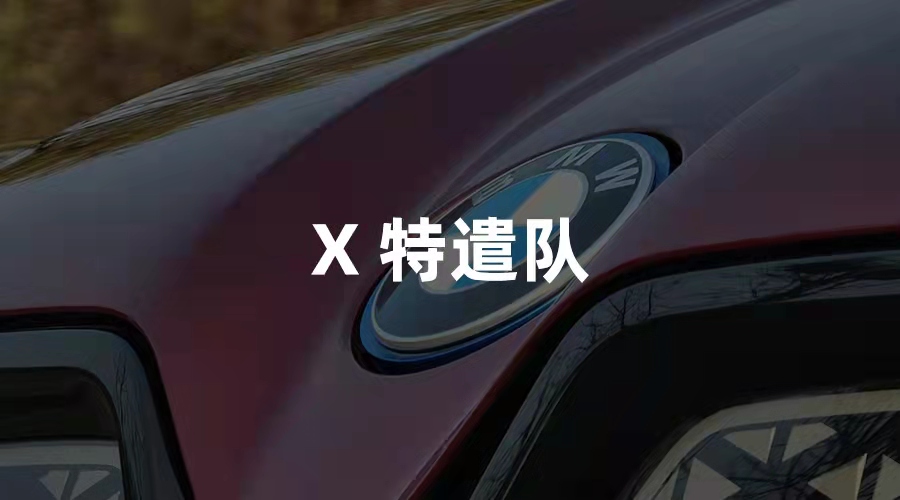Yesterday afternoon, I drove a BMW iX for a short and intense drive in 10-degree Beijing. After arriving at my destination, I saw an average energy consumption of 21 kWh/100 km on the instrument panel, which I thought was okay.
However, my colleague, a coach, told me that it was not my actual energy consumption. After opening the energy consumption menu, I saw the real data recorded by the system: 18.5 kWh/100 km.
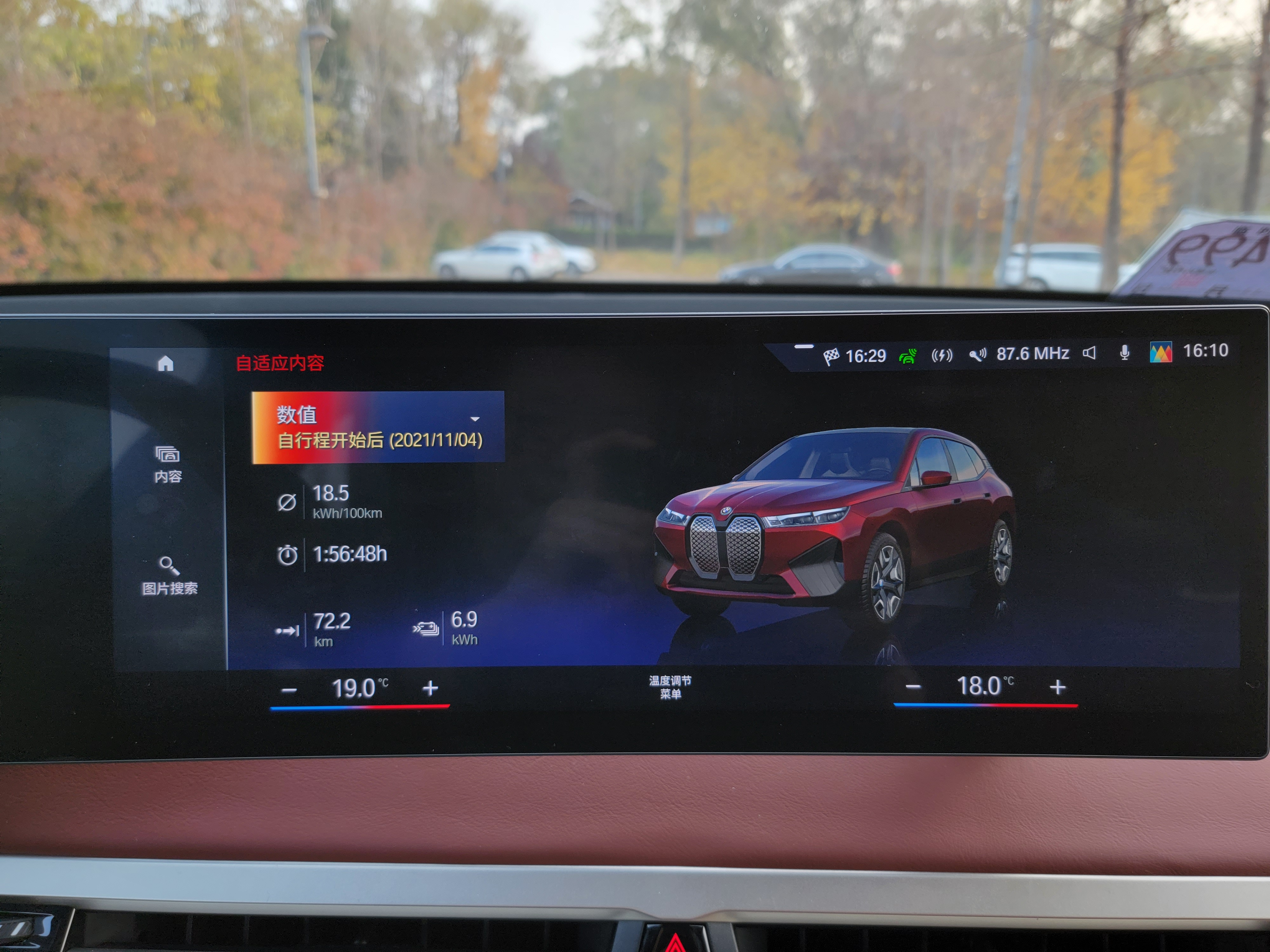
Considering the size of this mid-size SUV – with dimensions of 4,953 × 1,967 × 1,695 mm, a wheelbase of 3,000 mm, a maximum power of 523 horsepower with dual motors, a 0 to 100 km/h acceleration of 4.6 seconds and a weight of over 2.5 tons, equipped with four 22-inch 275 wide tires which are not energy-efficient – achieving such energy consumption performance is not simple.
Looking back at my experience test driving the iX throughout the day, except for the infotainment system, there wasn’t much to be criticized on this car. I thought about it further and considered the iX being launched at the Guangzhou Motor Show, which indicates that the iX is likely to be the only product benchmarking against Model X in the domestic market next year.
Therefore, this car is definitely worth discussing.
Design: Dramatic Changes Inside and Out
First, let’s take a look at this car.
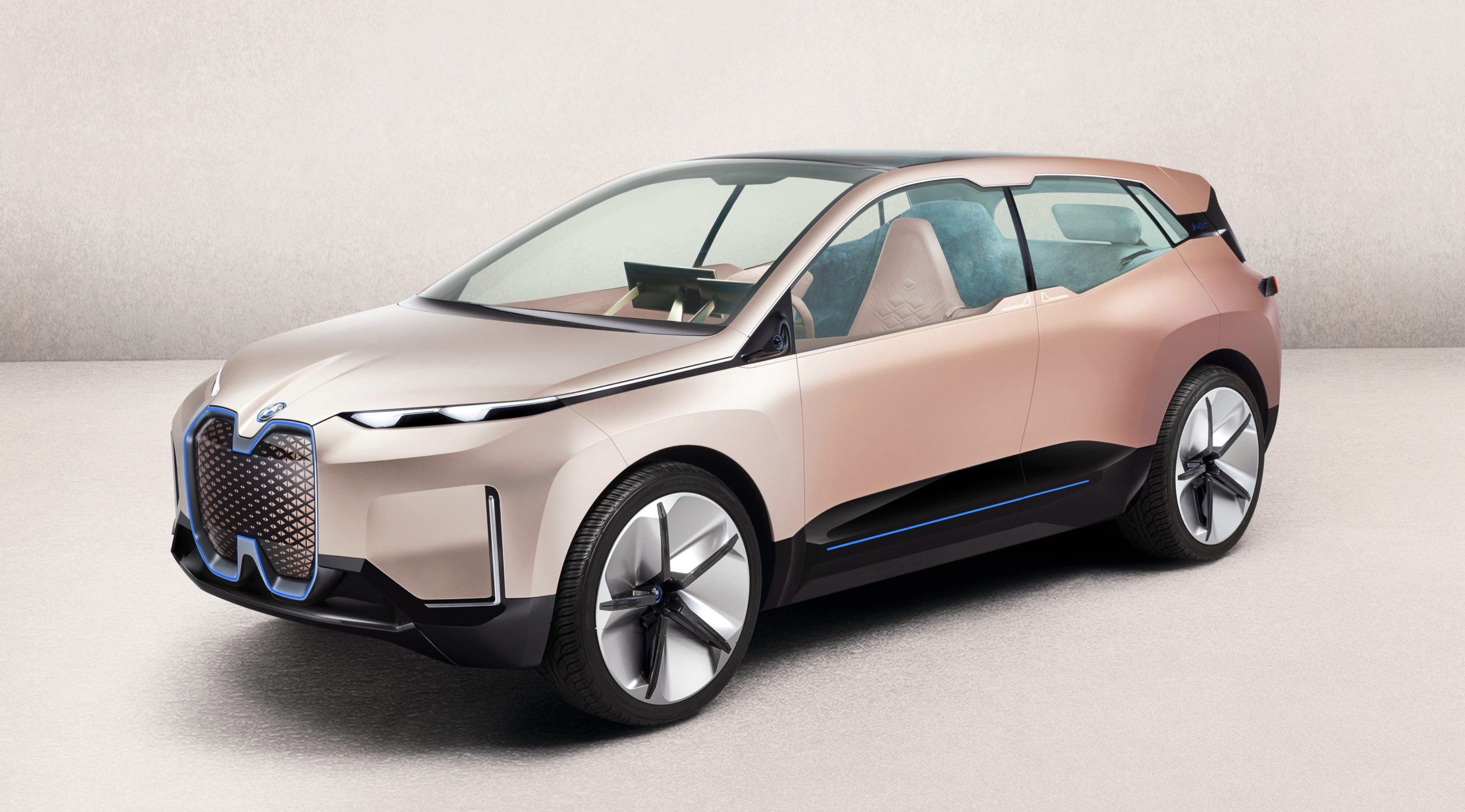
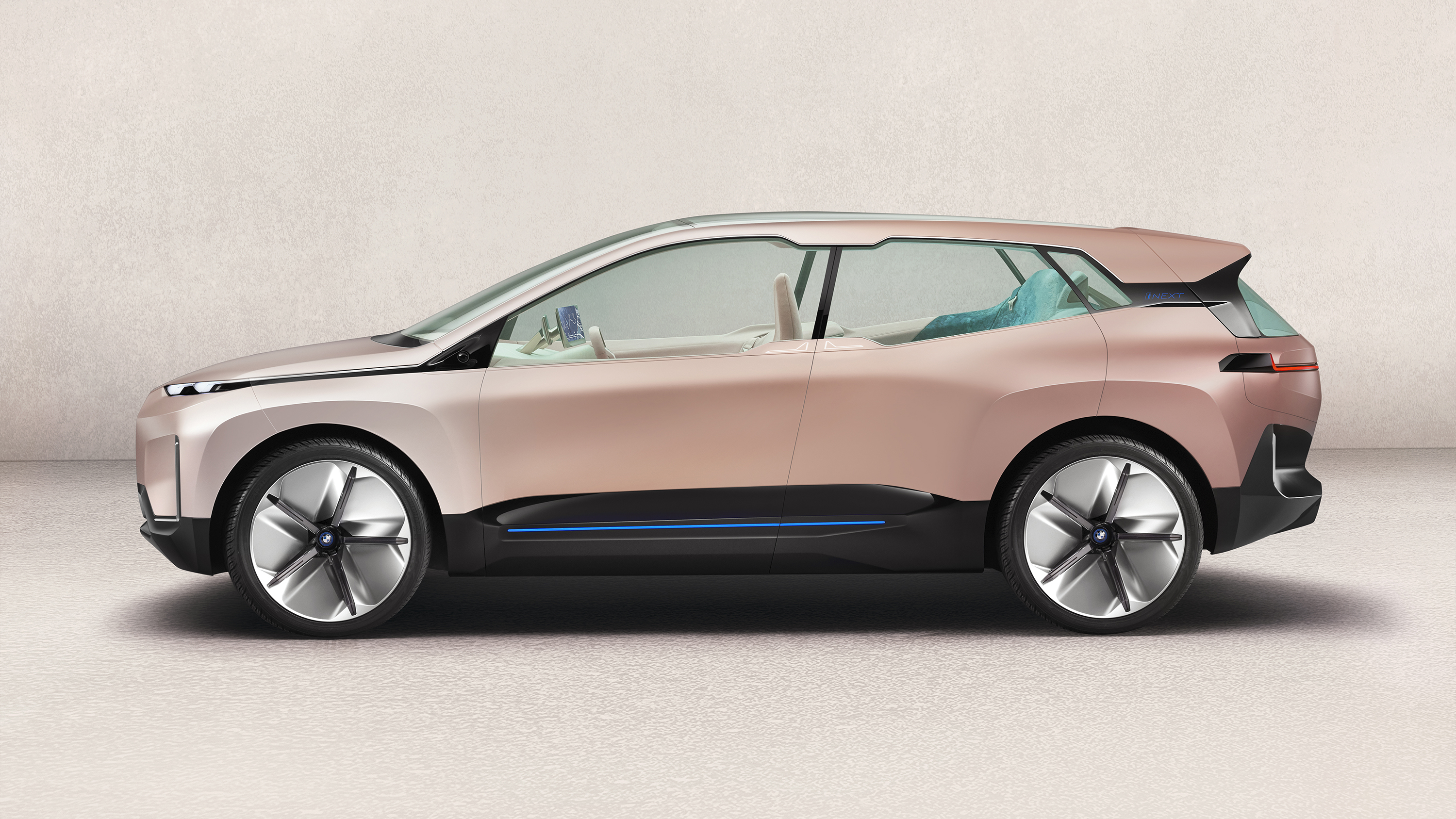

This is the Vision iNEXT concept car that BMW unveiled at the Paris Motor Show in November 2018, showcasing its vision for the future of electric vehicles.
Three years later, in October 2020, the production version of the iNEXT concept car was officially unveiled as the iX, BMW’s first SUV based on a pure electric platform, positioned as an electric car model at the level of the X6.
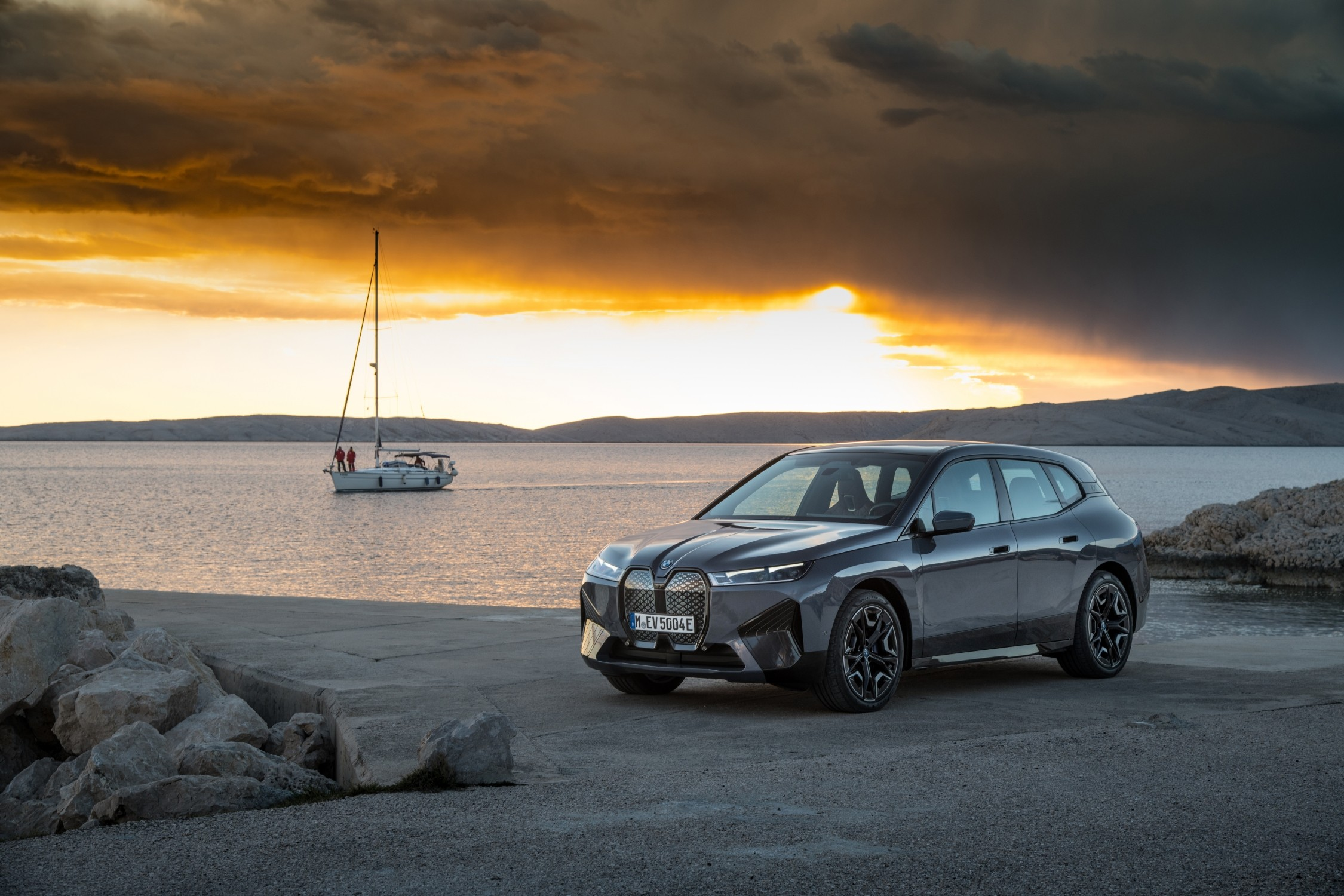
Introduction of New FeaturesHowever, it must be said that as the mass production version of iNEXT, the iX looks only similar to the concept car and has undergone many changes to details. Additionally, as a BMW model featuring a brand new design language, the iX has made bold and innovative attempts in both exterior and interior design.
According to social media feedback, it seems that people are not very accepting of this new design language, with most of the criticism focused on the front face.
Looking at the actual car driven today, the iX’s front face can hardly be called a BMW, with the entire front-end silhouette boxy and square. The vertical “double kidneys” with black and gold patterns are extremely eye-catching, far from being as introverted and gentle as previous mid-to-large luxury SUVs. Instead, it resembles a fashion show model, with capital coldness and exaggeration everywhere.
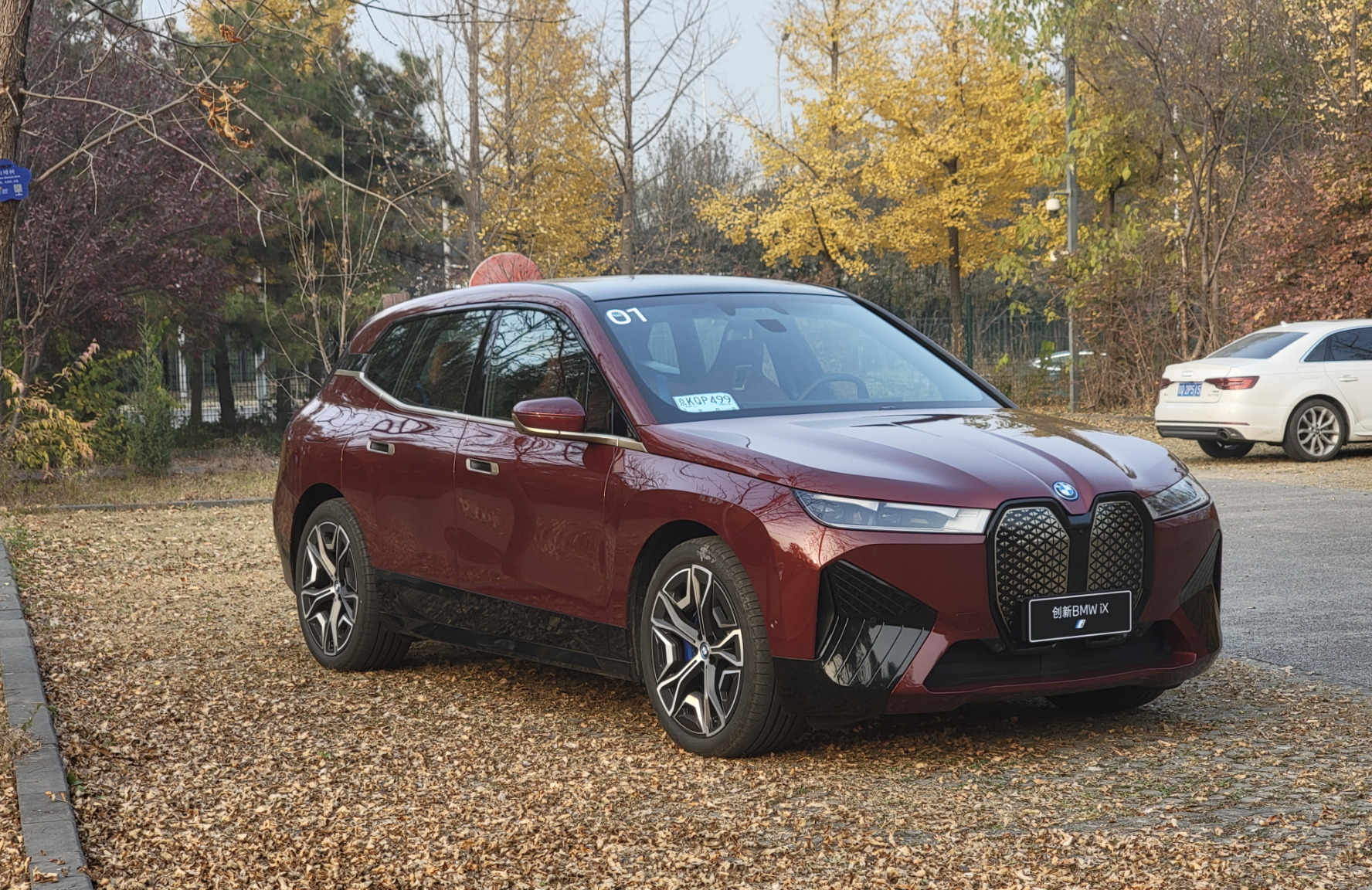
Looking from the side, the wind-facing area of the grille is almost straight and vertically facing forward, a design that has not been widely used except by Rolls-Royce, but the left and right sides of the iX have slightly angled back.
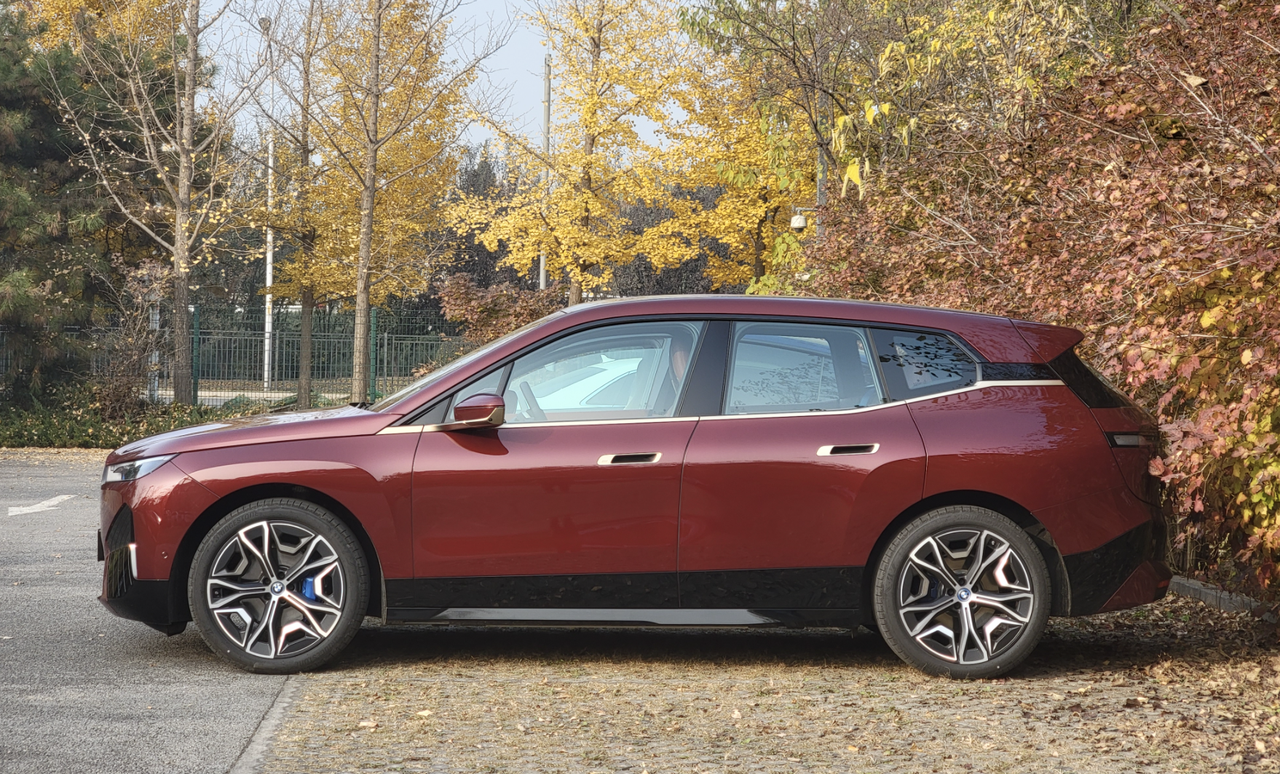
For those who are used to the beauty of streamline, seeing the iX front face should feel like switching from a classical piano piece to electronic music in an instant. Under the impact of strong electric bass, the brain may not be able to handle it without taking a break, and it will be impossible to appreciate this new type of play immediately.
But for someone like me who enjoys electronic music, I personally prefer the new design on the iX more than disliking it, except for one thing – the shape of the headlight that looks like Guan Yu’s big knife.
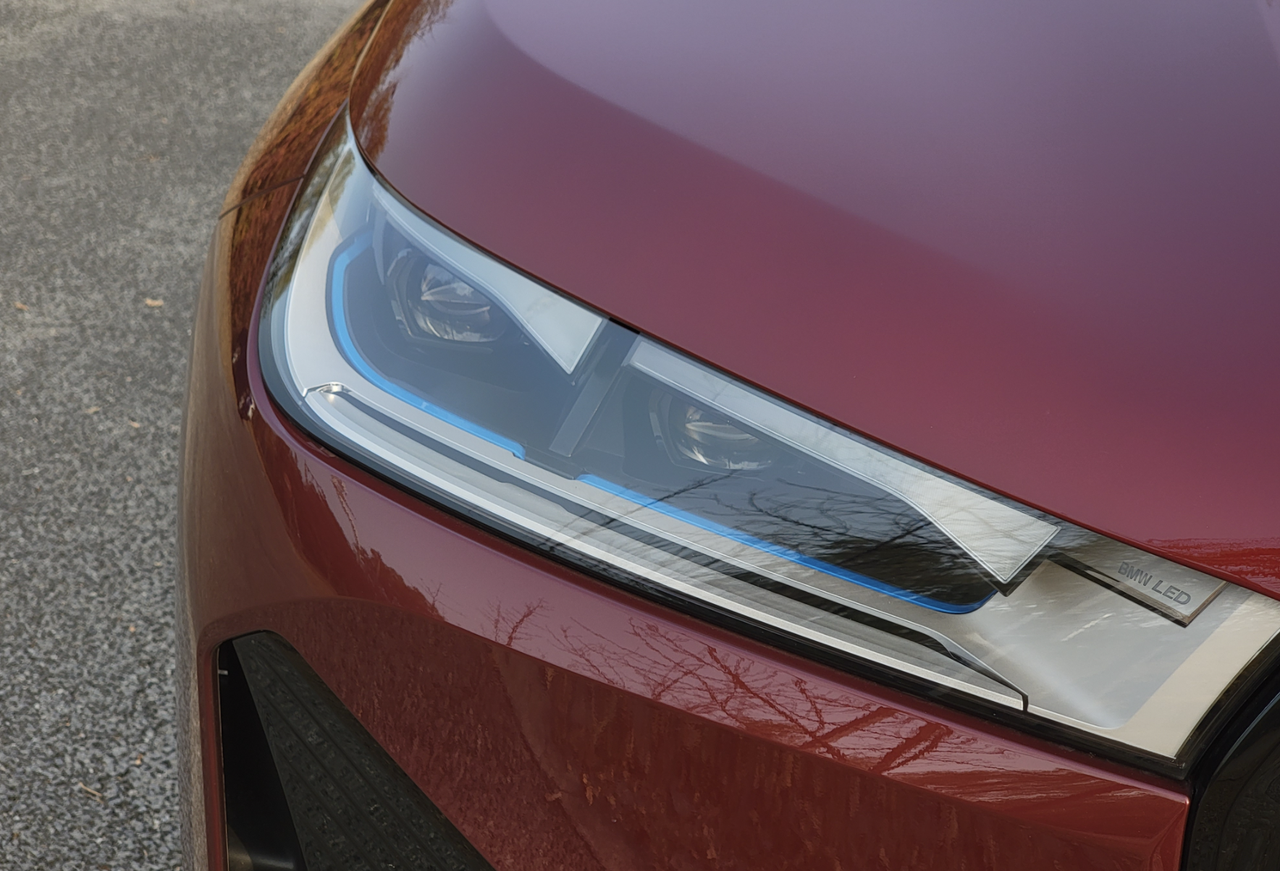
In my opinion, this “Guan Yu’s big knife”-like lampshade has an effect that influences the radical and sharp lines on the iX front face, making them look less aggressive. I was expecting the iX’s headlights to be the same as the concept car, featuring long straight lines with laser headlights.
In addition, the high-gloss black cone-shaped surround in the iX’s front face, 22-inch multi-spoke wheels, and the combination of Bordeaux red, high-gloss black and champagne gold colors are all styles that I like.
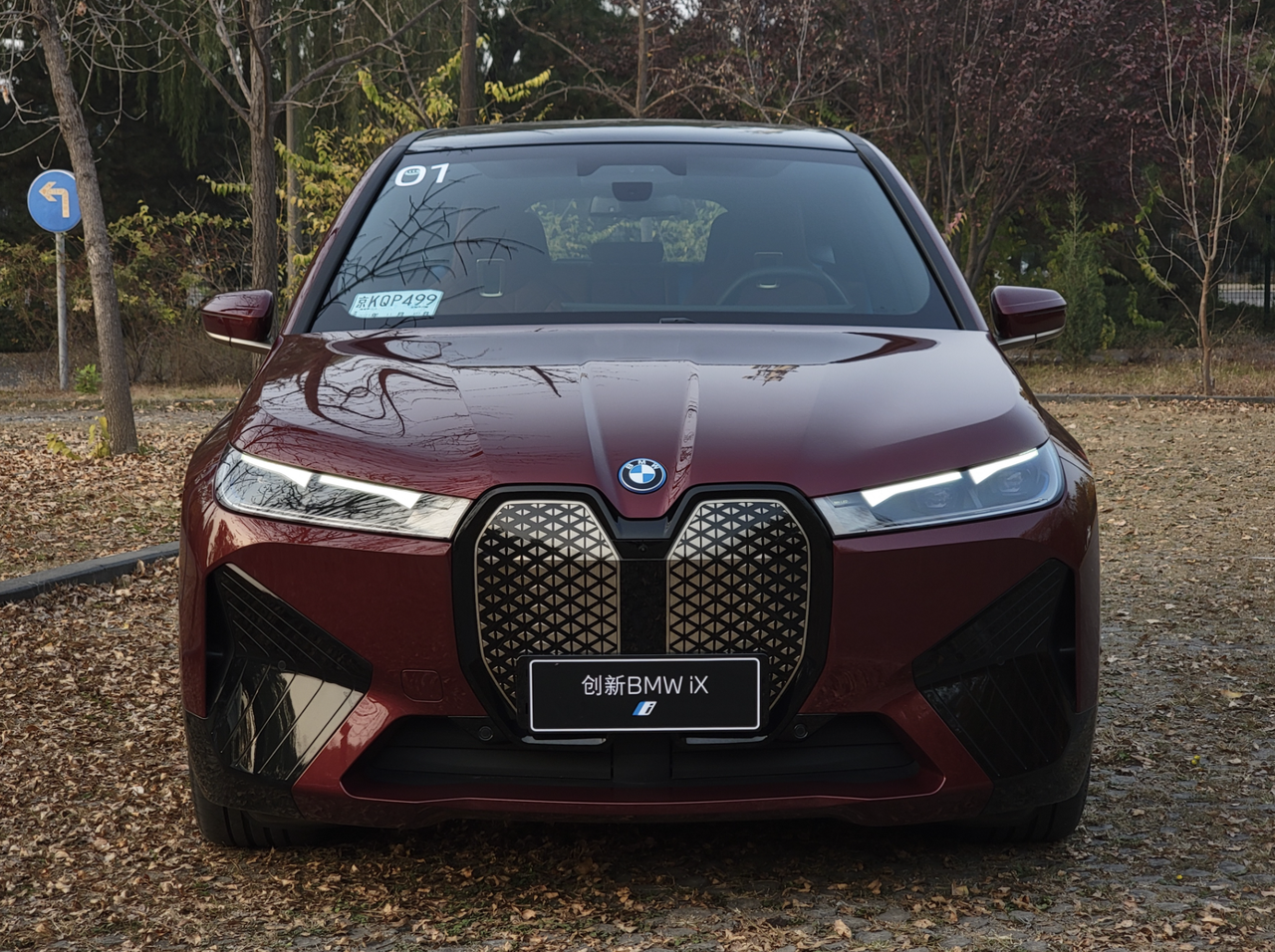
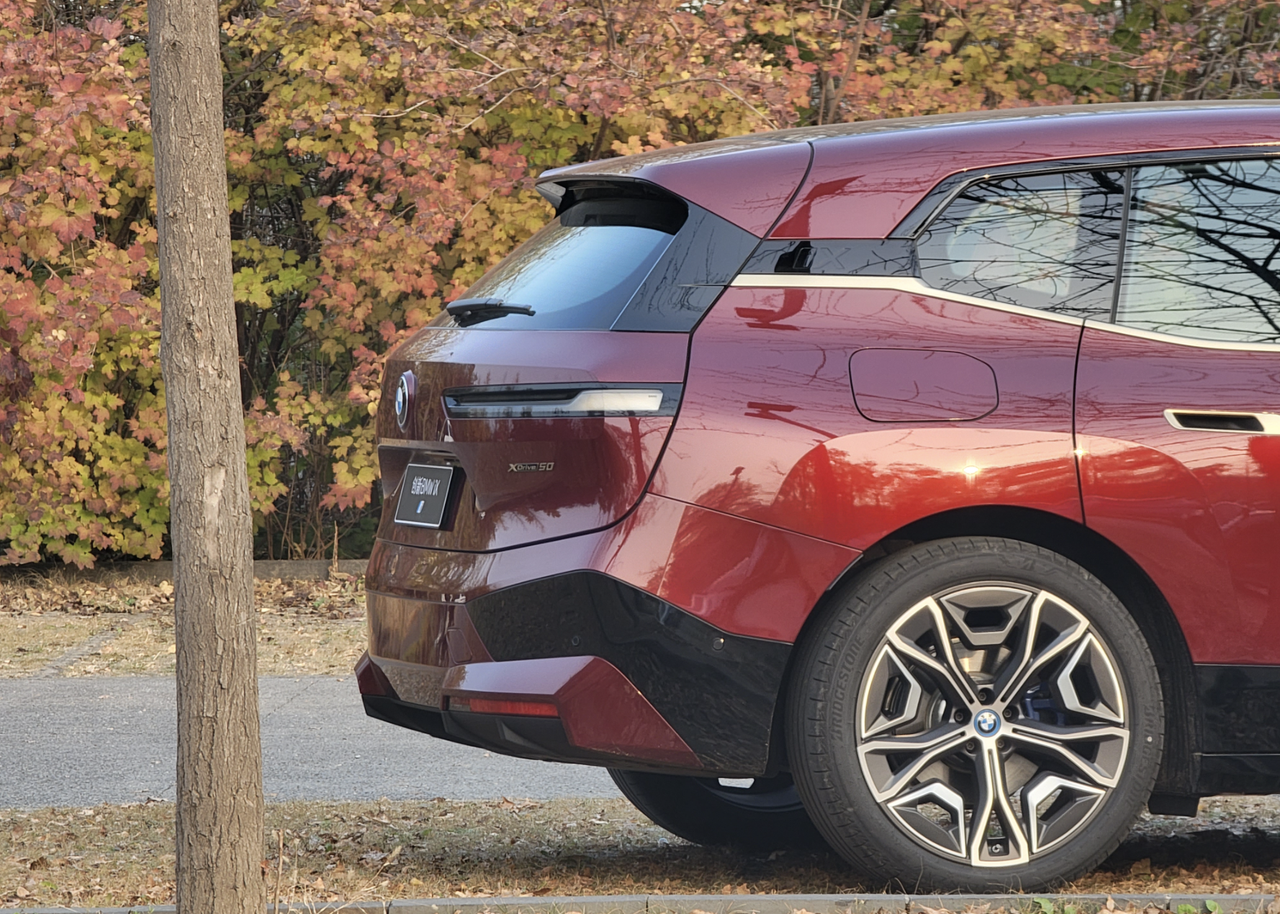
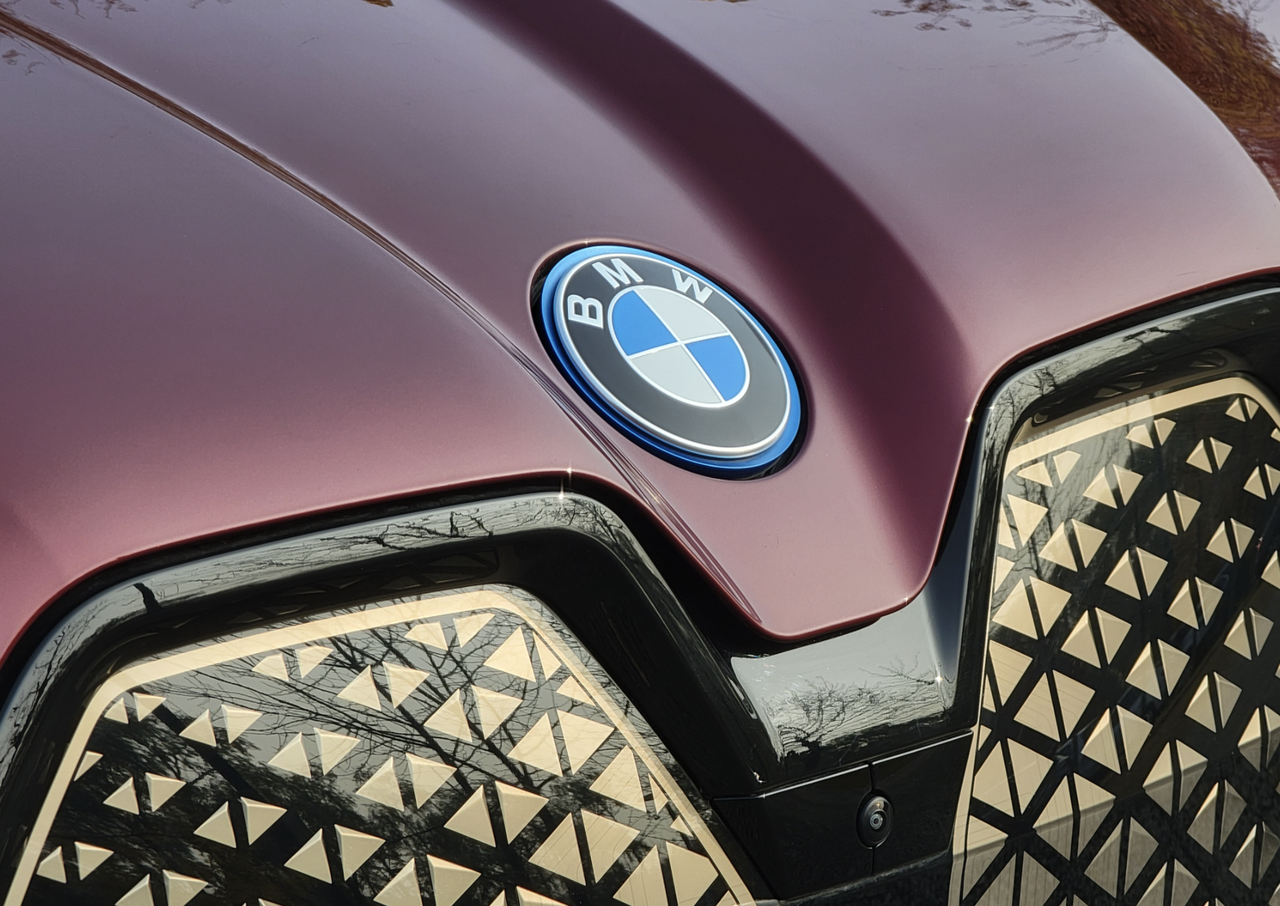 Compared to the controversial front face, the side lines of iX look more visually pleasing, and the rear wheels are not excessively pulled back in pursuit of a four-wheel square layout like some pure electric cars. The height of iX, 8 cm lower than X5, also makes iX look more slender, and the visual center of gravity on the side is extremely coordinated and balanced.
Compared to the controversial front face, the side lines of iX look more visually pleasing, and the rear wheels are not excessively pulled back in pursuit of a four-wheel square layout like some pure electric cars. The height of iX, 8 cm lower than X5, also makes iX look more slender, and the visual center of gravity on the side is extremely coordinated and balanced.
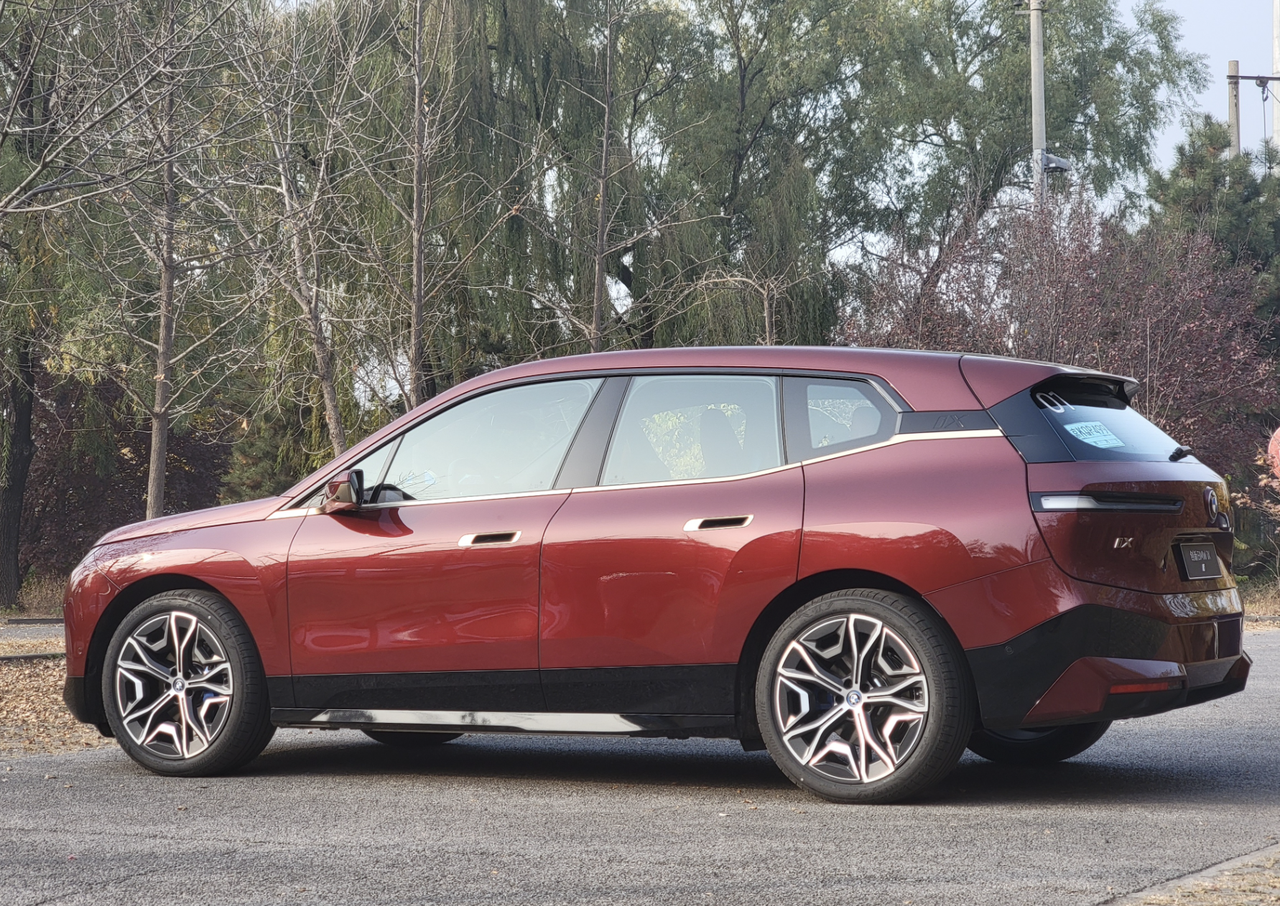
The most futuristic perspective of the whole iX is the tail. The trend of the upper narrow and the lower wide lines make the posture of iX extremely dynamic. The originally low visual proportion matches the obvious outward tilt of the rear wheels, making it appear as a very full and sporty car. The thick linear taillights do not adopt the common “one section for the tailgate and one section for the side skirts” separate taillight design, but the entire light strip is on the tailgate, which can be regarded as a boon for OCD.
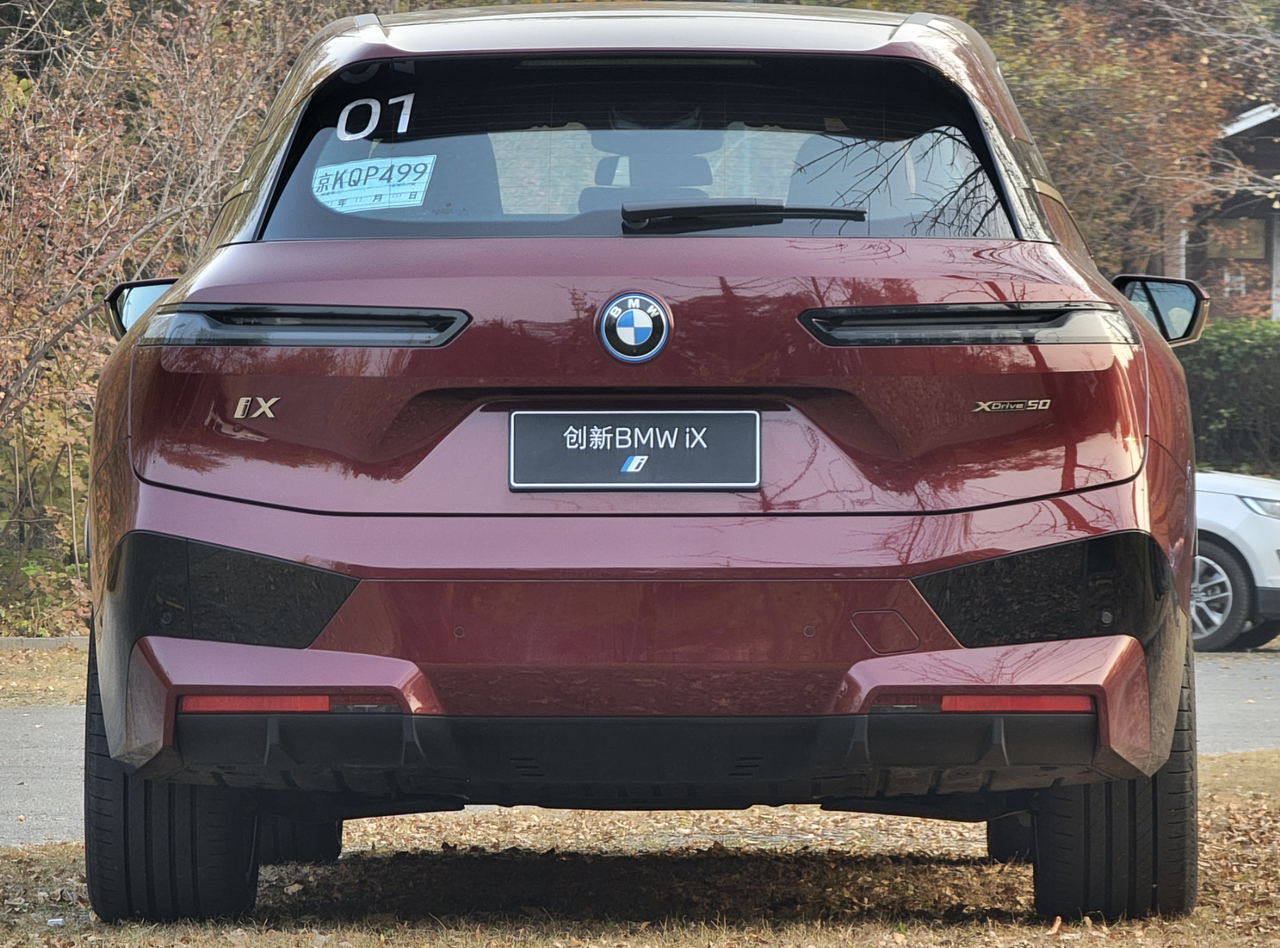
The best detail of the iX tail is that after the protruding taillights are lit, there will be a very beautiful gradient effect from red to white from the inside out, like white mist solidified into amber while blending into red liquid, hazy and transparent.
The black “BMW” letters on the headlamp eyebrows are clear and just right against the white background. They are conspicuous enough when viewed up close, and imperceptible when viewed from a distance, demonstrating exquisite restraint.
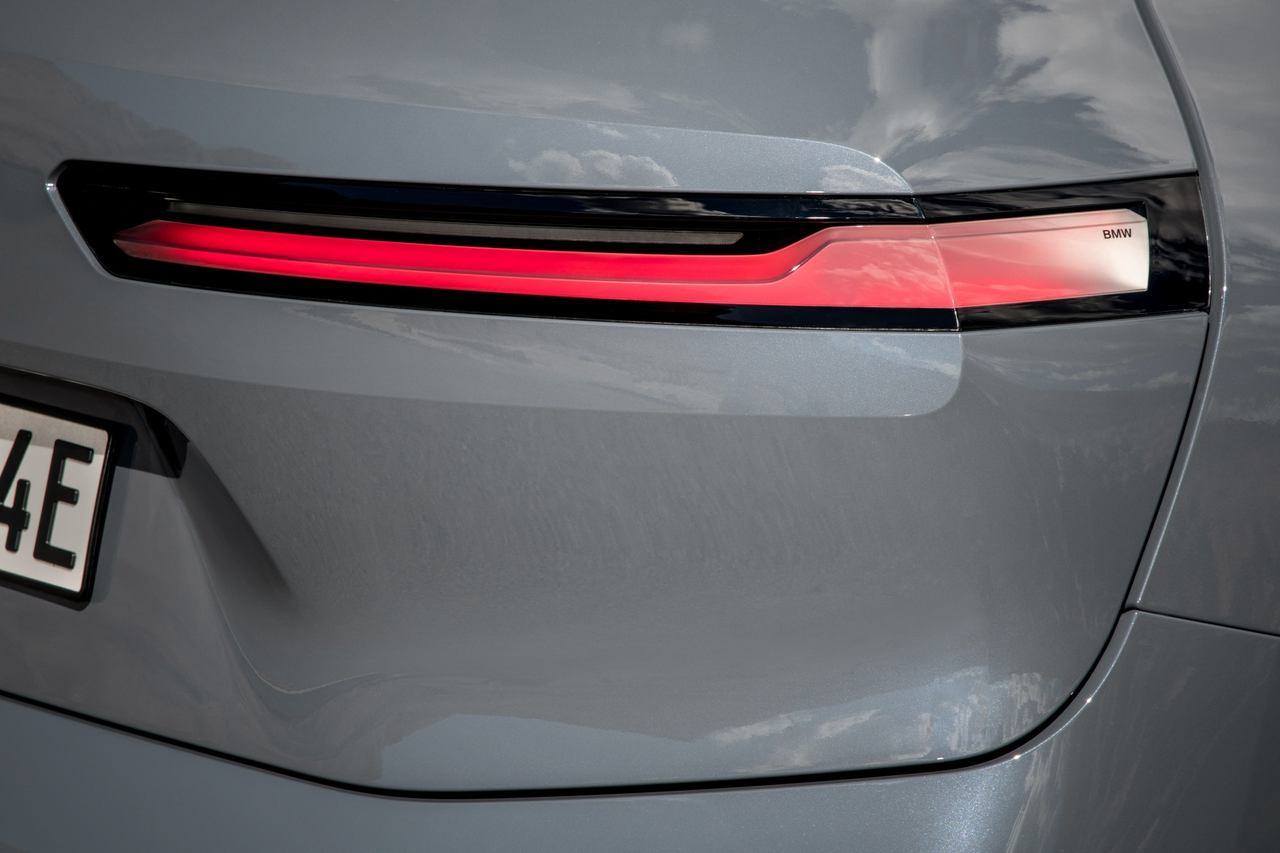
If you have the opportunity to see the actual car, I believe everyone can more intuitively feel the attractiveness of these details displayed by iX.
This Interior is Very French
When it comes to the interior, the changes of iX compared to the previous BMW models are even greater than the exterior, completely breaking free from my inherent impression of “German style”.
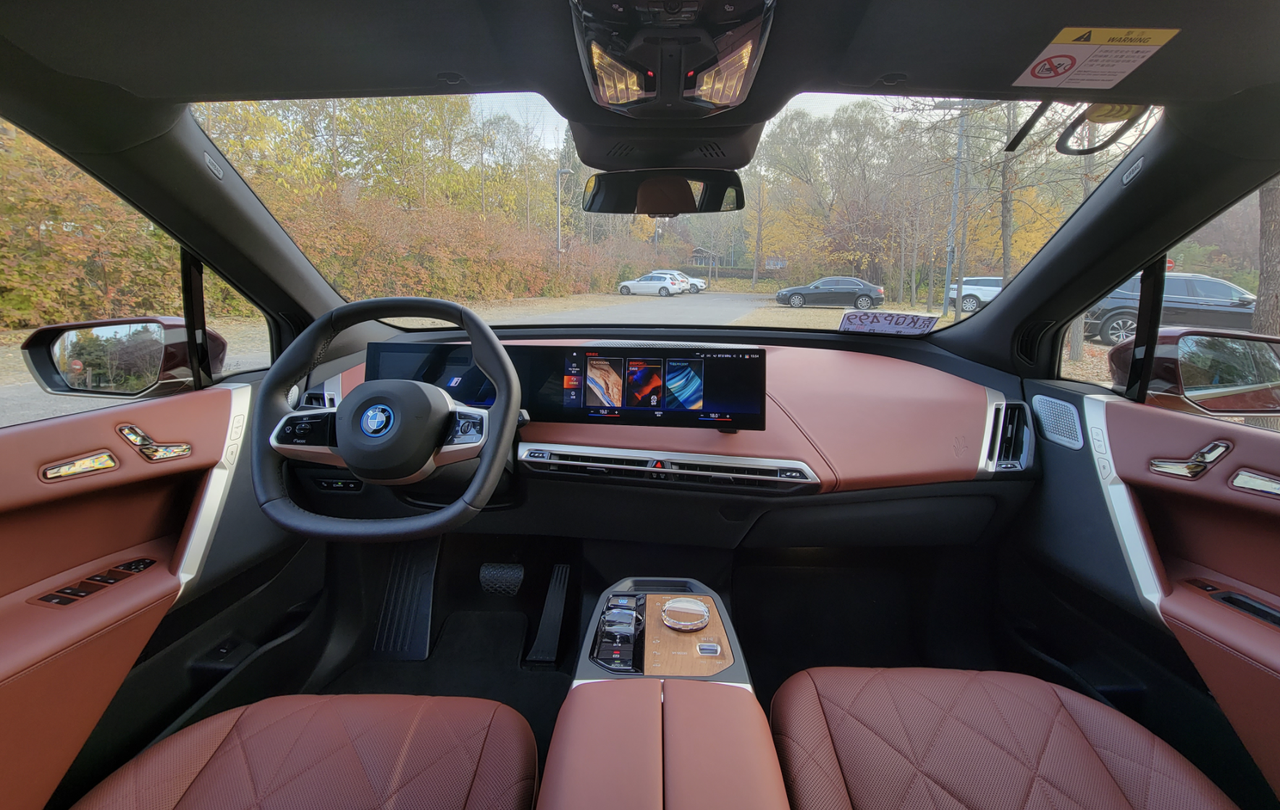
The stylish and bold color matching, and the combination of various materials are reminiscent of the atmosphere of modern home design. For a moment, I even felt like I entered a flagship French car.
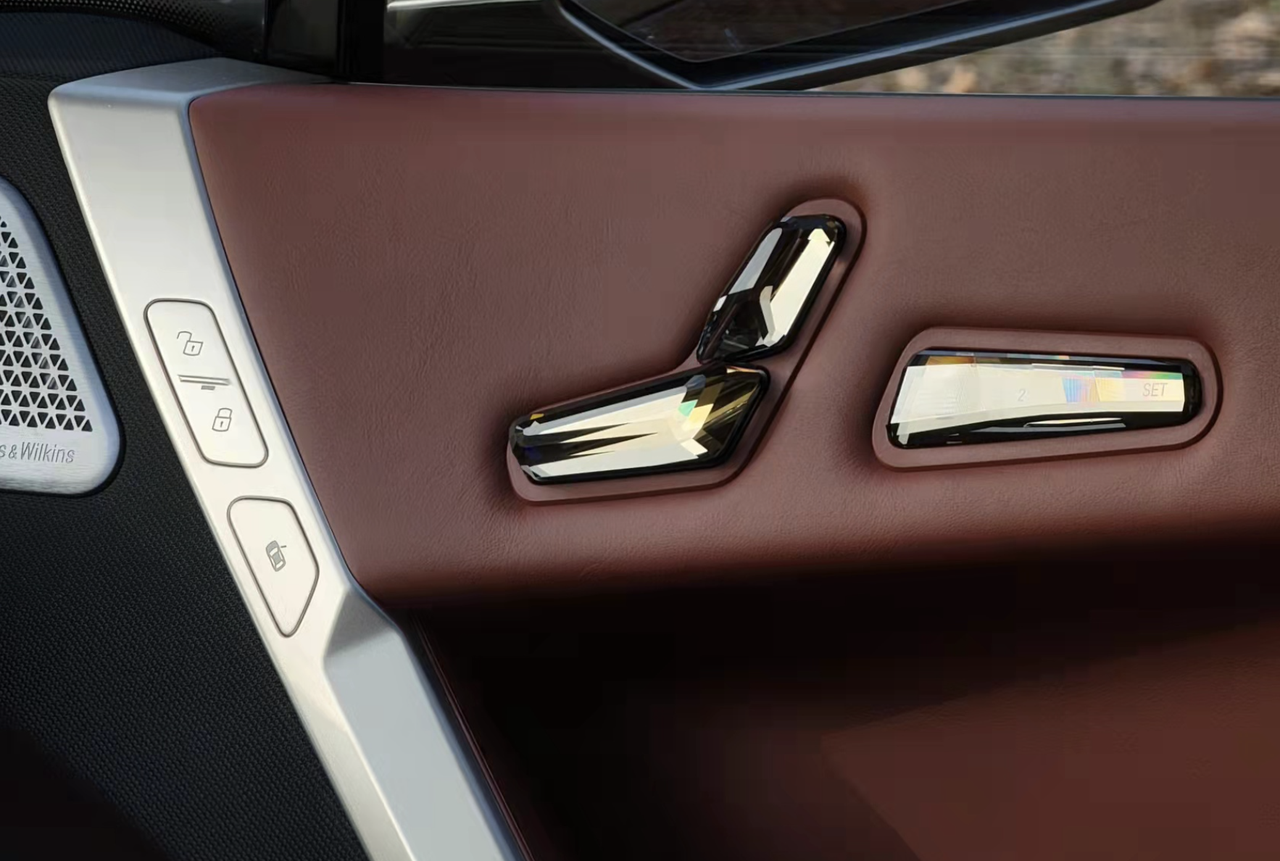
The seat adjustments on the car door, the start/stop button, gear lever, volume, and iDrive buttons on the central armrest are all made of crystal glass material. The key zone with white backlight under the wood is also a combination of texture and modernity.
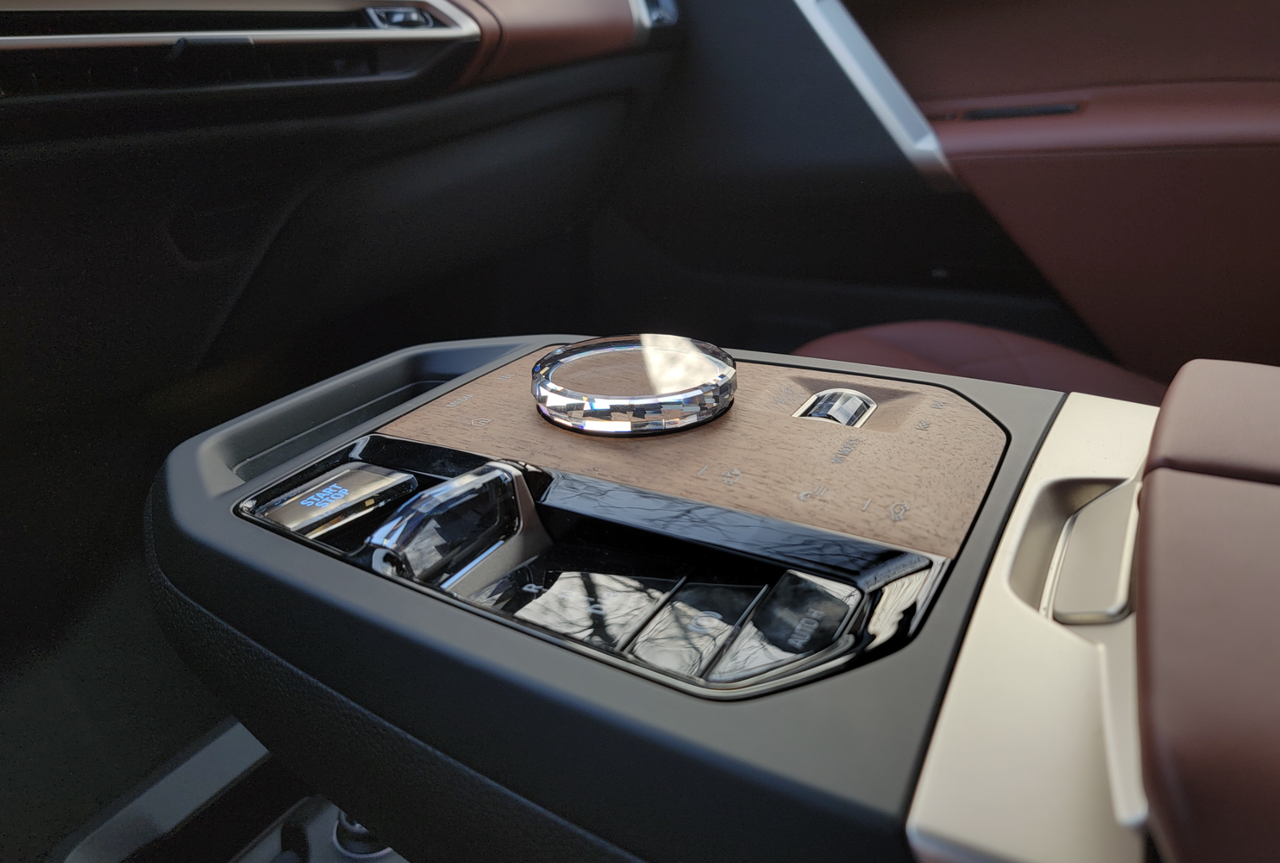 The combination of the second row’s red slanted seats with blue seatbelts is a rather innovative design, giving a sense of fashion and sophistication. As a pure electric platform model, the iX’s rear floor is flat, as expected, and the rear seat padding is quite comfortable. The soft leather material that comes into contact with the body extends to the door frames, and the rounded corners on both sides make it easier to get in and out of the car. The button for folding the seats is also located under the seat near the door, making it easily accessible.
The combination of the second row’s red slanted seats with blue seatbelts is a rather innovative design, giving a sense of fashion and sophistication. As a pure electric platform model, the iX’s rear floor is flat, as expected, and the rear seat padding is quite comfortable. The soft leather material that comes into contact with the body extends to the door frames, and the rounded corners on both sides make it easier to get in and out of the car. The button for folding the seats is also located under the seat near the door, making it easily accessible.
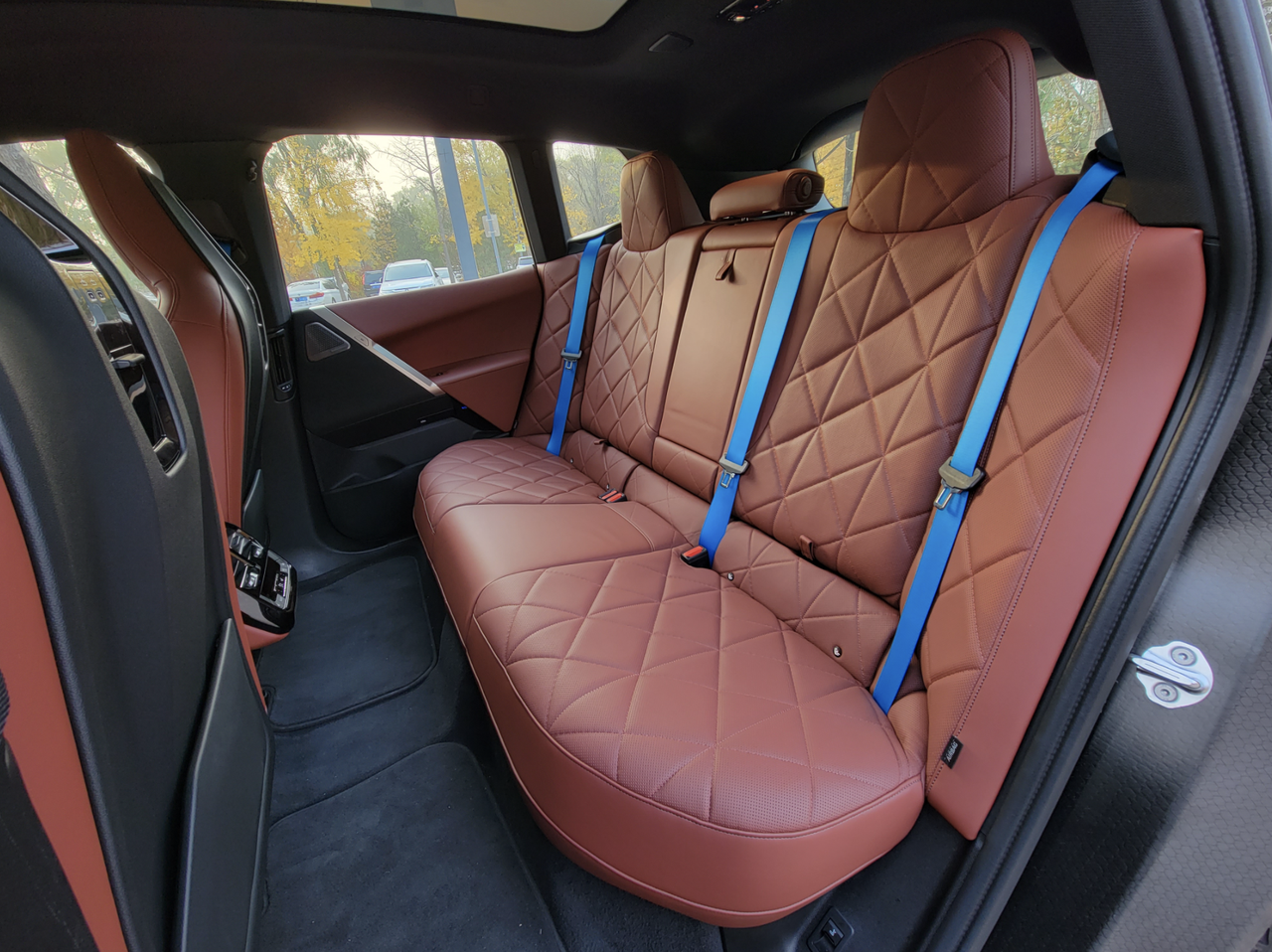
If there are still debates about the exterior design of the iX, its interior design is a comprehensive improvement in terms of visual appeal, texture, taste, and temperament.
However, now it’s time to talk about the biggest flaw of the iX – the car’s system.
Better not to have too much expectation for the system
The iX is BMW’s first vehicle to feature the ID8 system, and BMW even held a global online launch event for it. One of the highlights was that the ID8 uses a brand new UI design, with more shortcut cards on the center console’s homepage. The rendering of various patterns in the system corresponds to the iX’s overall design style, with many details using the iX’s advertising theme color, Champagne Gold.
Another highlight is the new voice system, which has a new ID image, resembling many different-sized glowing bubbles. This voice system has powerful capabilities, and there are many AI and personalized settings included.
In short, the launch event was very exciting. However, the reality proves that we shouldn’t have high expectations for German car systems at this stage.
Decent screen, average system
Compared to the ID7 that we experienced on other BMW models, the ID8 on the iX is indeed an improvement, mostly thanks to the new dual-screen. The resolution and contrast of the dual-screen are comparable to mobile electronic devices, making it one of the top-level screens among car infotainment systems. It looks great and the touch response is fast.
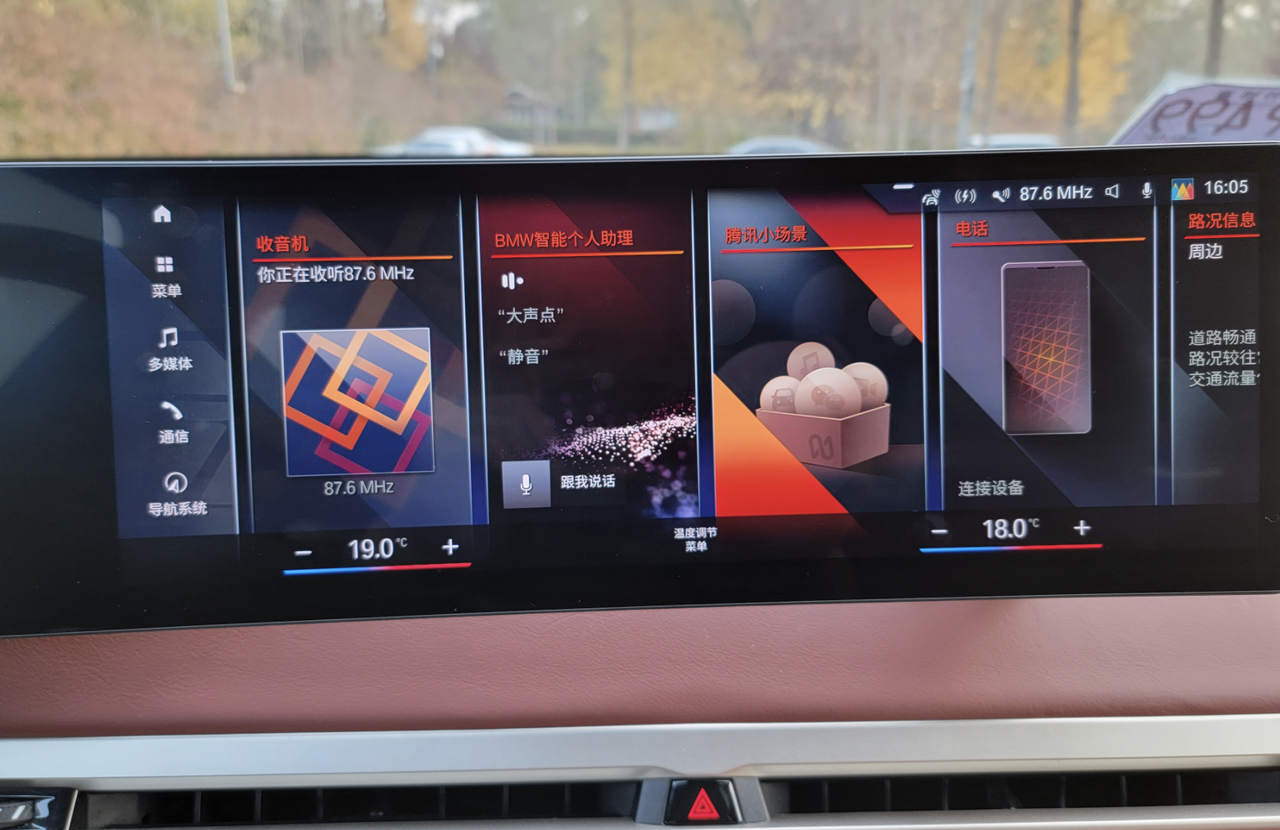
The larger central screen makes it more convenient to operate on various touch interactions compared to the small screen before. More shortcut cards are available on the homepage that can be slid to the right to select other cards. It gives me a feeling of an ideal car infotainment system.
However, once you enter the settings, you’ll immediately notice the first old problem – too many menu levels.
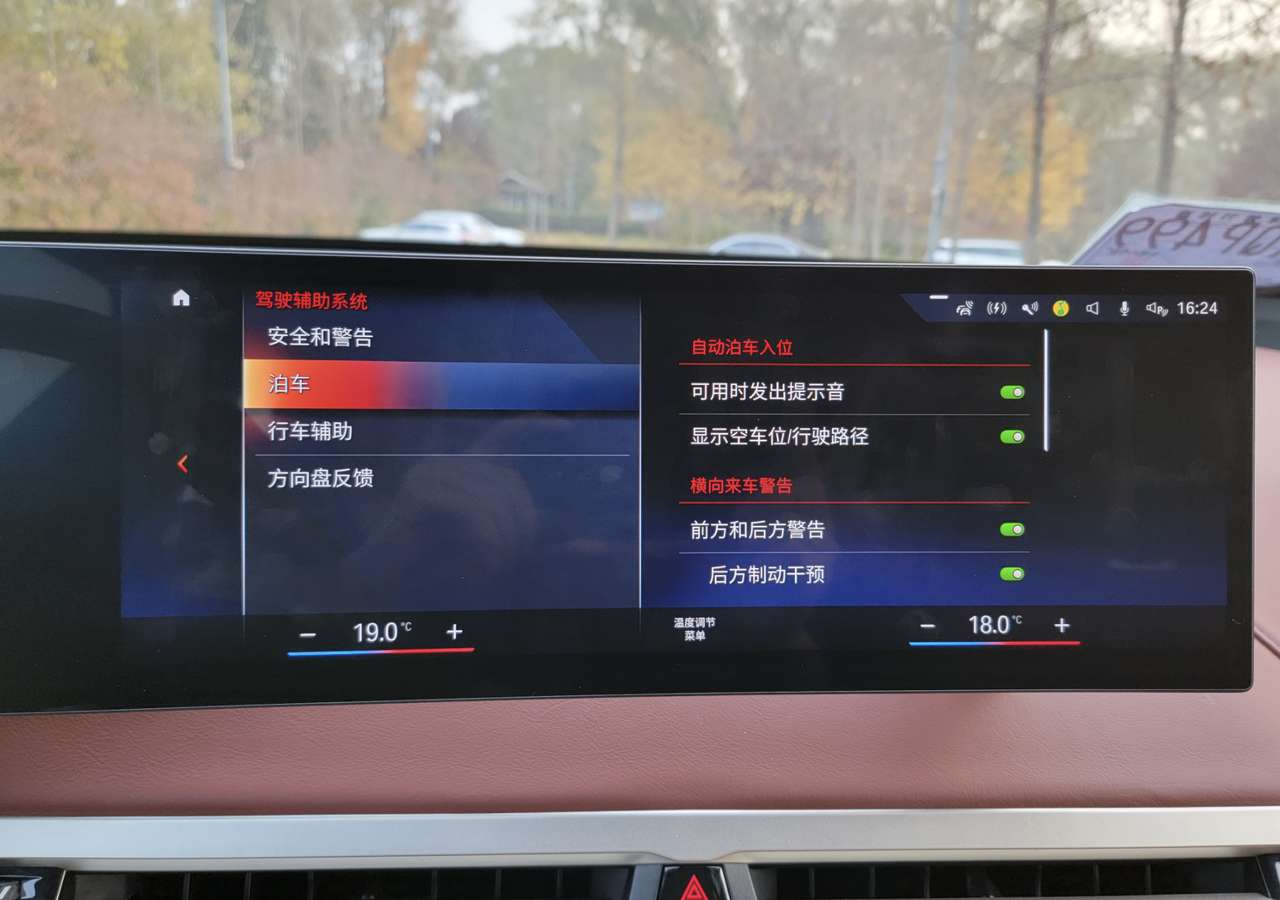 If I want to modify the energy recovery setting of the vehicle, I need to first click the “Menu” on the left side of the homepage, then enter the full-screen application drawer, find the corresponding settings application, and then go to the energy recovery settings page. It takes one or two more levels of settings to achieve this.
If I want to modify the energy recovery setting of the vehicle, I need to first click the “Menu” on the left side of the homepage, then enter the full-screen application drawer, find the corresponding settings application, and then go to the energy recovery settings page. It takes one or two more levels of settings to achieve this.
The excessive hierarchy of the menu causes too many operation steps and often occupies the full screen, making it difficult to see the “return path”. In my use, I often can’t remember the path I set before when I need to use it again. It feels like entering search mode, and you have to search to find where the desired function is hidden.
The second issue is the quality of visual presentation.
I just praised the color gamut and resolution of the iX dual screens earlier, but in terms of the smoothness of dynamic display, the iX feels relatively ordinary. Both the left and right sliding pages on the homepage and the up and down sliding pages in the menu can feel obvious trailing. Whether it is due to insufficient frame rate of the rendering animation or insufficient refresh rate of the screen itself is unknown.
In addition, the lack of display quality is also reflected in the various “inconsistent styles” of the entire UI, such as the fast access cards on the homepage are one style, and then the icon style in the menu immediately makes people feel like they have gone back a few years in the Internet era. On the localized application Tencent Xiao Jing, it is another style, and the display of various menu levels is missing a sense of overall unity except for some colors and details.
And the font design used by the iX’s entire vehicle system looks a bit monotonous and outdated in 2021.
The third issue is the voice system. Maybe because the test drive car is not the final version, the software still needs to be optimized. The feeling of using the brand new voice system on the ID8 is not significantly better than that of the ID7. Opening the tailgate and switching driving modes cannot be achieved by voice. To activate the driver window system, you need to ask “which side” to confirm. But in the mirror area of the front row of the iX, I saw microphones for both the driver and passenger.
The actual response speed of the voice assistant’s wake-up is good, but after being awakened, it takes a few seconds for a prompt sound to appear. If it is awakened by the driver, the animation of the voice assistant will be displayed on the HUD instead of the central control. Therefore, when I tried various voice operations after parking, I kept staring at the central control and didn’t see the animation of the voice assistant. Combined with the delayed appearance of the wake-up prompt sound, I thought the wake-up had failed.
It has shortcomings, but it is also “better than not enough”
The criticism section of the iX car system ends here. It should be pointed out that if we compare it to the systems of the three major automakers BMW, Benz, and Audi, the iDrive of BMW is actually quite good, and it is more advanced in the logic of the system hierarchy and the way of physical and touch interaction.Here’s the translation in English Markdown with HTML tags preserved:
After pointing out the shortcomings of iX when compared with the best newly manufactured cars, which have achieved world-class levels in interaction, information display and voice control of the car’s computer, it is evident that iX still has a significant gap in these aspects.
After venting about the biggest flaw in iX, it’s time to talk about the impressive aspects of this car.
BMW, it’s all about the driving experience
If I had to pick the most impressive aspect of iX, it would undoubtedly be the driving experience.
Before discussing the driving experience of iX, I would like to emphasize one thing again: even in the field of electric cars, the quick response and linearity of the throttle is relative to that of fuel-powered cars, and the difference between excellent and low-quality calibration is significant, which applies to the driving experience as well.
Now, onto my verdict on the experience of driving iX: an outstanding mid-size SUV that overtakes X5 and is excellent in multiple aspects.
Incredible field of vision
Let’s take a look at the three-dimensional dimensions of iX first: 4,953 × 1,967 × 1,695 mm. It is a mid-size SUV with a length of nearly 5 meters. Yet, the vision I get when sitting in the front seat of iX is surprisingly broad.
Here’s a photo of the vision from the passenger’s seat.
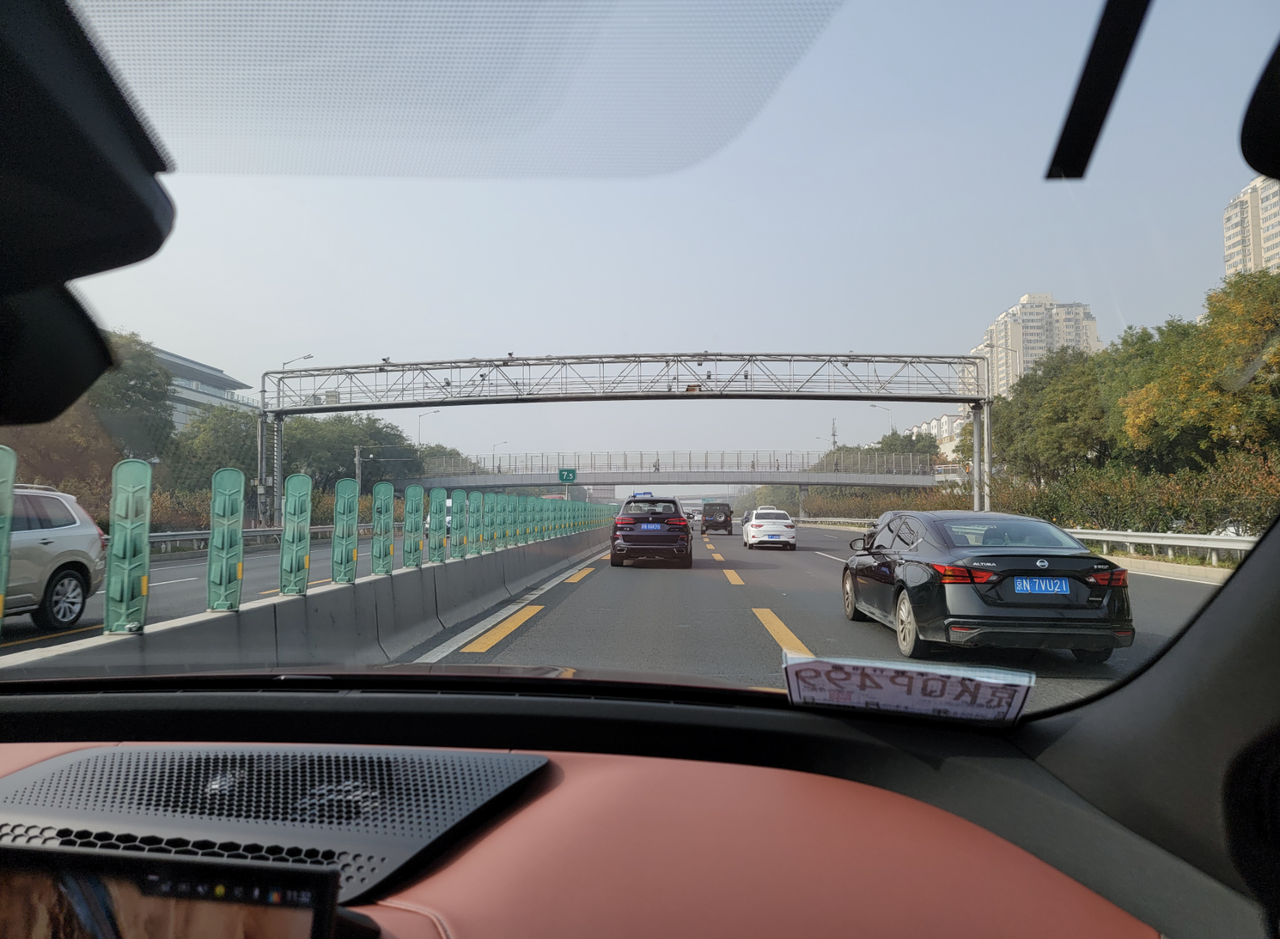
This is a wide-angle photo taken from the same position.
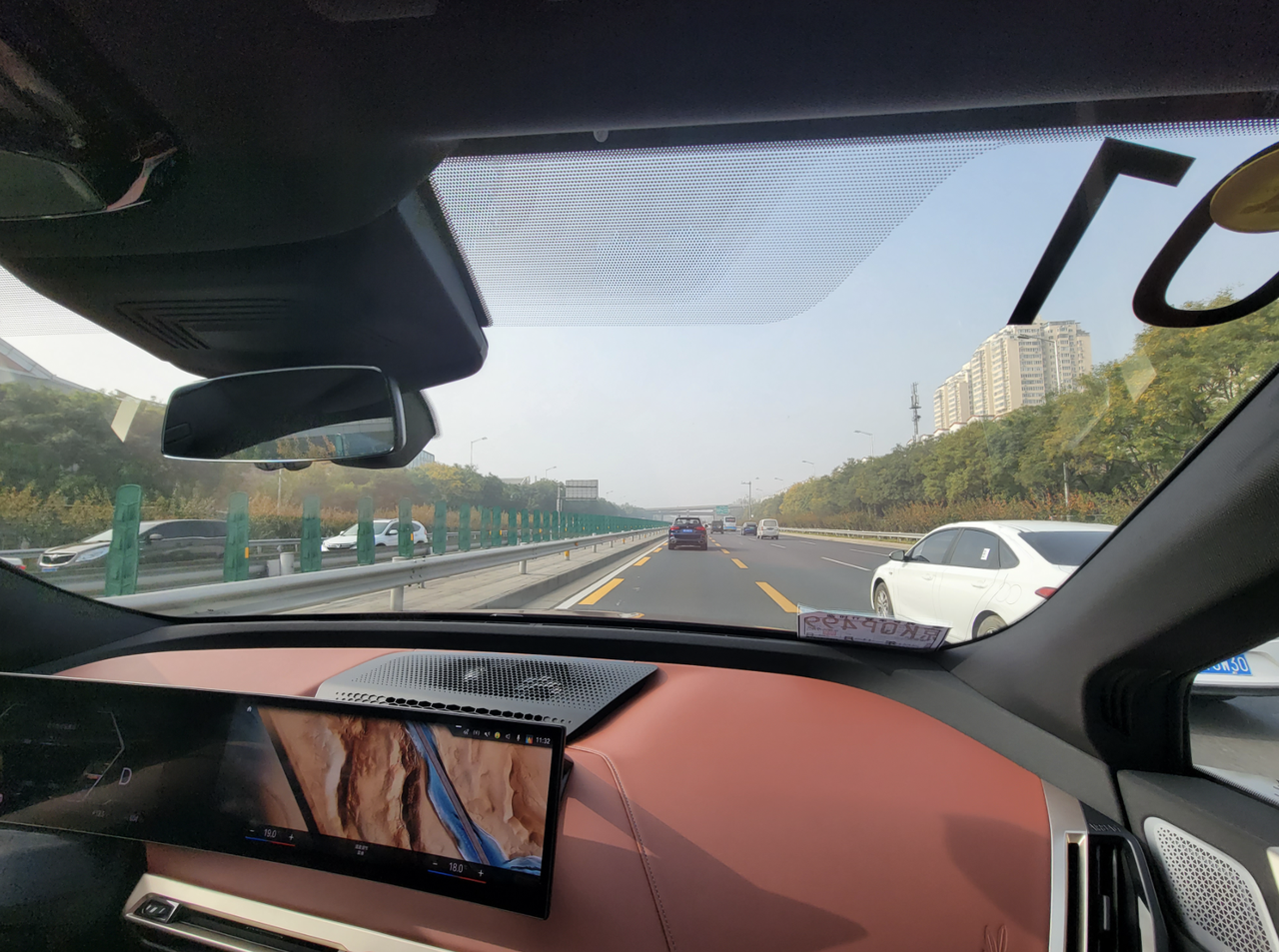
The broad field of vision is due to several factors. Firstly, the height of the entire front instrument panel of iX is very low, and the height of the instrument panel is lower than my chest in a normal sitting position, making it easier to see downwards.
Secondly, the front cabin of iX is a diving curve, and my line of sight is almost tangential to it, so the front view is not obstructed by the front hood. This feeling is similar to that of Tesla’s SUV models. What’s more fantastic is that the hood of the front cabin looks like an arc from inside the car, while the left-front and right-front corners of the vehicle seem to retract into the car, providing a great sense of spaciousness.
The front windshield of iX is large, and the part extending to the roof is quite long. When looking forward, there is almost no obstruction in the part of the peripheral vision above. The slope angle of the two A-pillars is large enough, and they are in a position that conveniently avoids the blind spot of the lateral vision during large-angle turns.
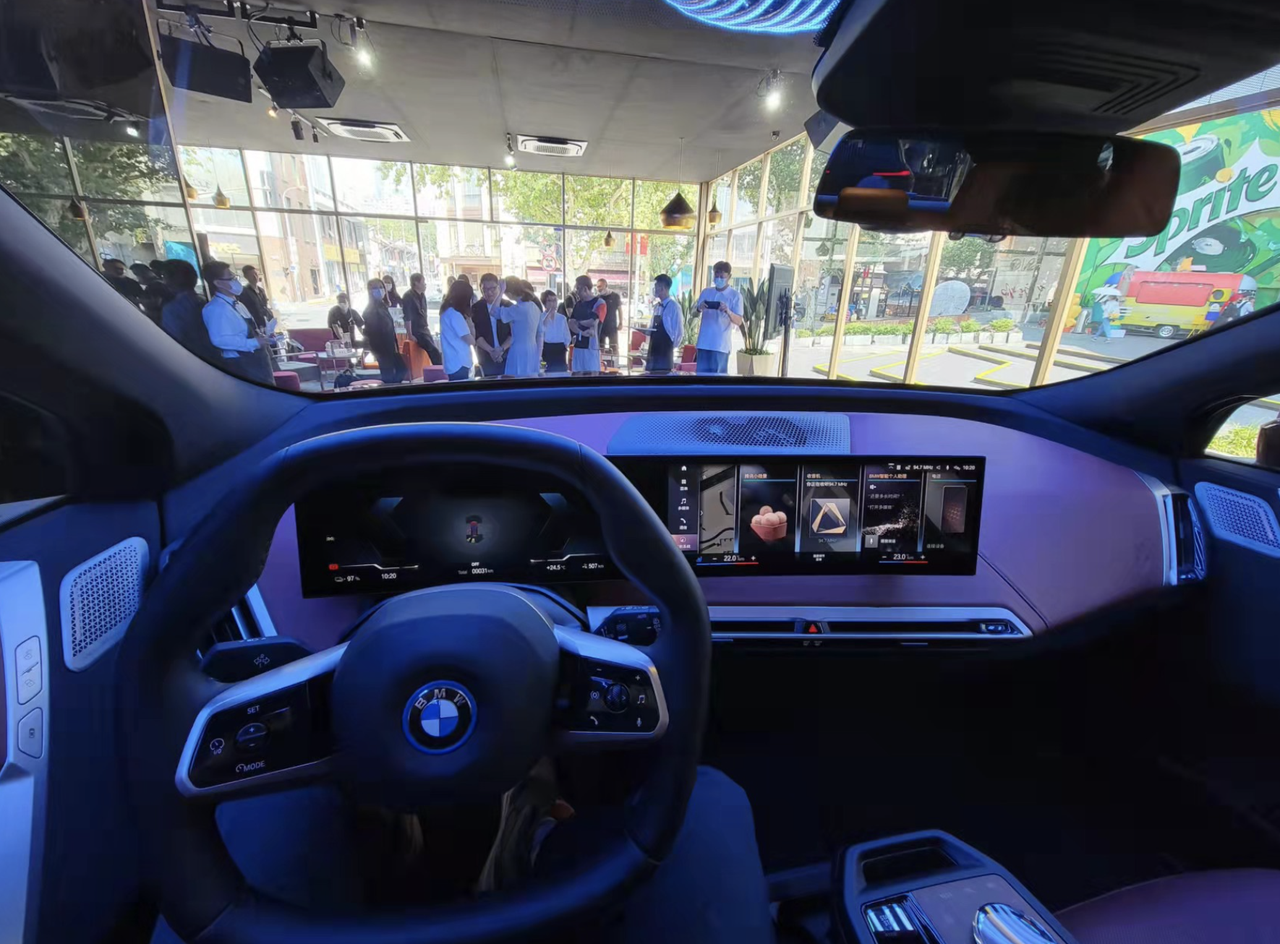 With such a broad view and the cleverly designed curved enclosure of the front row interior, iX cleverly reduces the sense of volume and tension as a large vehicle in visual perception by minimizing the presence of the width and front of the car. After a day’s test drive, whether it’s various small roads in and out of underground garages or tight lane changes and overtaking in congested road conditions, this first-time-driving iX made me feel very reassured.
With such a broad view and the cleverly designed curved enclosure of the front row interior, iX cleverly reduces the sense of volume and tension as a large vehicle in visual perception by minimizing the presence of the width and front of the car. After a day’s test drive, whether it’s various small roads in and out of underground garages or tight lane changes and overtaking in congested road conditions, this first-time-driving iX made me feel very reassured.
However, this is not entirely due to the view.
When Top Ingredients Meet Gold Medal Chefs
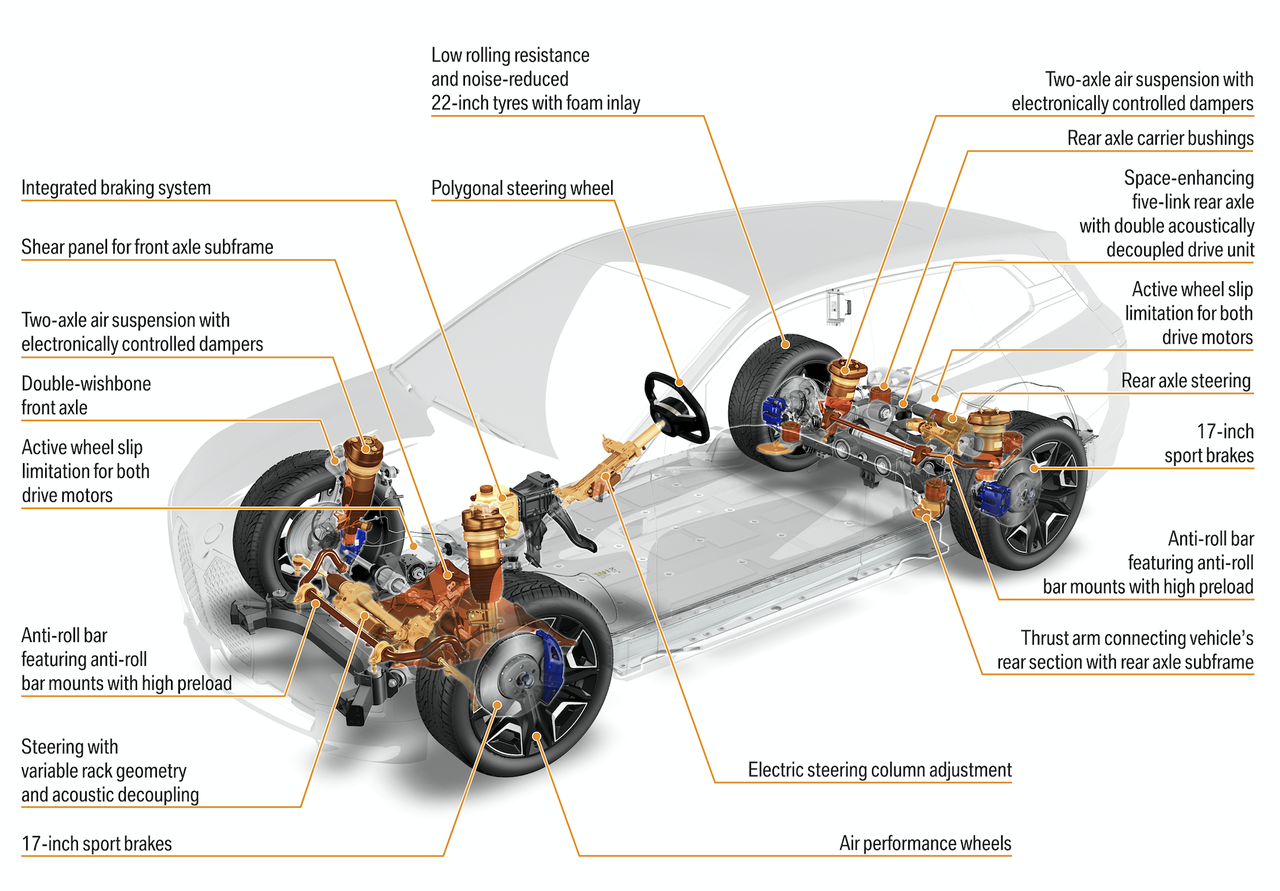
The mechanical configuration of the iX lives up to its flagship name. The configurations shown in the figure are listed briefly as follows: front double wishbone and rear five-link suspension, front and rear dual-chamber air suspension, variable steering ratio, front and rear high pre-load anti-roll bar, front and rear limited-slip electric drive system, 17-inch brake discs, 22-inch low-rolling resistance and silent cotton tires, and so on.
After the chassis, there is the body. The iX adopts the popular upper steel and lower aluminum body structure. The lower body is mainly made of cast aluminum parts, and the A and B pillars are made of ultra-high-strength hot-formed steel. The carbon fiber body structure that BMW has been using for many years has been applied more dramatically in the iX: the Carbon Cage, which connects the roof, A, B pillars and the entire side door frame structure together.
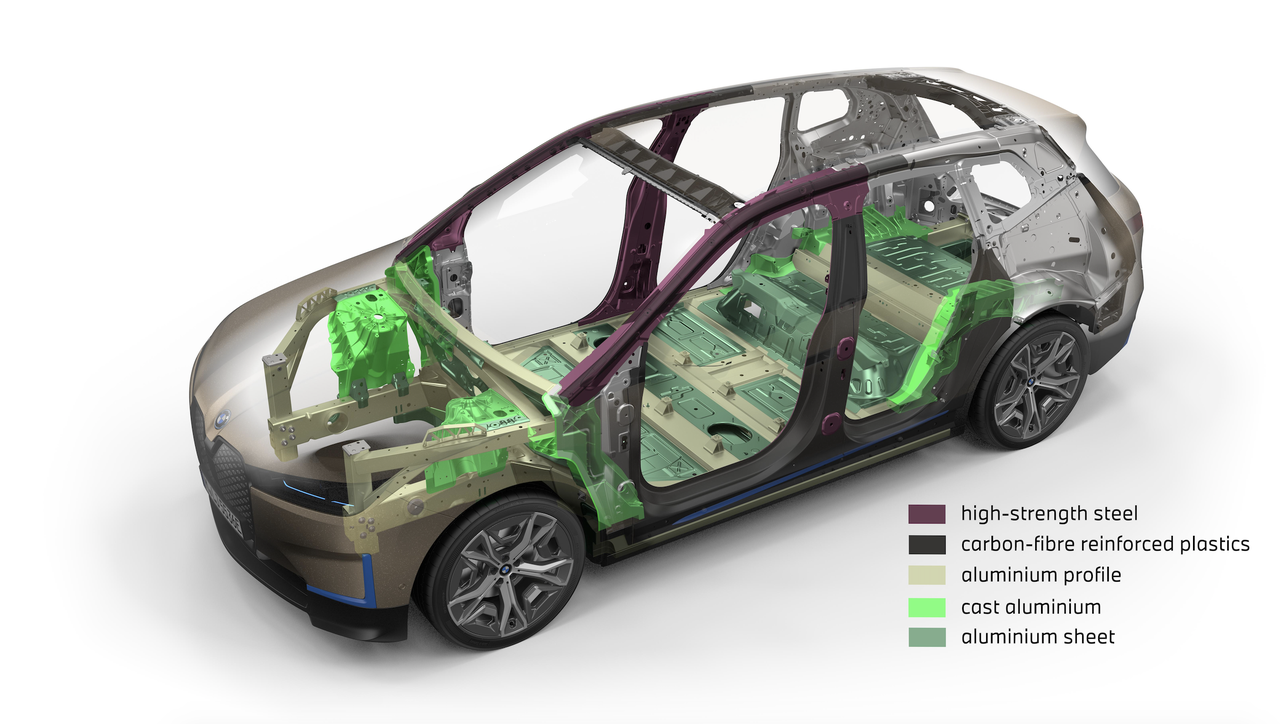
After the “armchair theory,” in actual driving, this mechanically configured high-end iX, under BMW’s tuning, is like being enchanted, almost subverting my perception of driving experience for large luxury SUVs.
It can be said that if you don’t look at the data, I wouldn’t think that the iX is a car weighing 2.5 tons. In addition to this, driving the iX doesn’t feel like driving an SUV, let alone a 3-meter-wheelbase SUV. Its steering feel in economy mode is very light, thanks to the support of the rear-axle steering system. The turning radius is also noticeably smaller than what should be reflected by its 3-meter wheelbase. Moreover, with fewer turn rounds, for iX, right-angled turns and underground car park turntables are not challenges.
At this state, the iX’s air suspension is also very gentle, diligently absorbing all kinds of ups and downs on the road. At the same time, it is remarkable that the vehicle body of the iX actually does not produce much pitching or rolling due to it; during high-speed cornering, the degree of tilt is entirely different from that in the comfort mode, and the vehicle’s rolling amplitude is very restrained, distinguishing it from the vast majority of its peers.
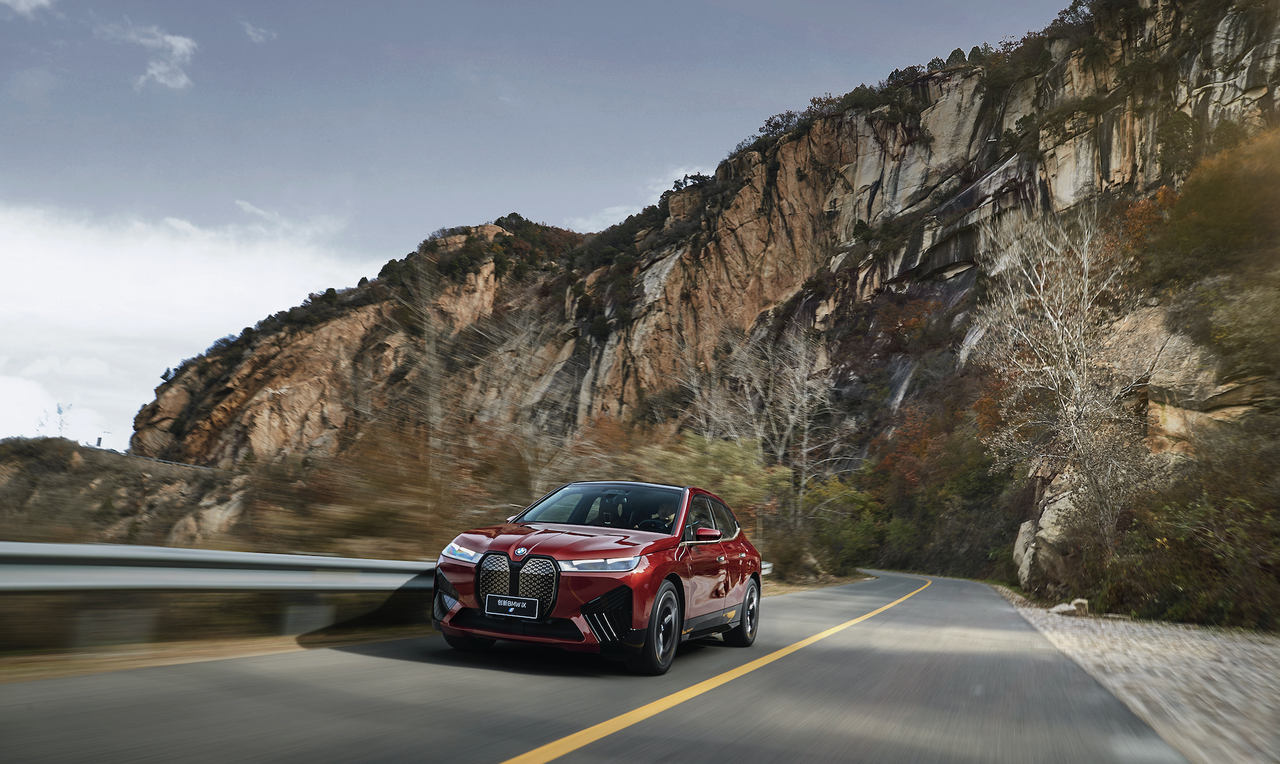
Accelerating with iX is still one of the best in the electric car industry. When the high-energy recovery mode is activated, the car speed control is very responsive, and the output delay is small and linear. The energy recovery is also linear and delayed when the pedal is released. I call this feature of electric cars the “acceleration and deceleration bidirectional low-delay linear calibration.” Although I have not driven a Taycan yet, among all the electric cars I have driven so far, only BMW has achieved this level of performance, except for Tesla.
Switching to sport mode, the car’s theme changes to a more passionate red, and a simulated “sound wave” with a “Dune”-themed BGM by Hans Zimmer begins to play in the cockpit.
Stepping on the accelerator, the car is quickly propelled forward with its 523 horsepower passing through four 275-width tires. The acceleration is fast, but there is no tire noise, no torque steering, and no high-frequency buzzing from the motor. The simulation sound wave adapts to the speed, which focuses and completely isolates the environment. The surroundings are immersed, and objects seem to move farther away. At 120 km/h, the HUD shows a speed warning, and I start to leave the “virtual world.”
In today’s age where you can buy a 3-second-level electric car for 300,000 yuan, the iX’s acceleration of 4.6 seconds may not be top-notch, but its calmness, quietness, and atmosphere are worth savoring. Due to the limited time and space for the test drive, I did not explore the iX’s cornering limits, but the car’s response to changes in direction was very satisfactory.
In terms of dynamic driving, the iX almost subverts my understanding of large luxury SUVs. While maintaining a high level of comfort and quietness, BMW cleverly hides the iX’s large size, long wheelbase, and heavy weight, making its performance exceptional in terms of posture and dynamic execution.
BMW’s Strongest Advanced Driving Configuration# Overview
42Mark’s test of the top 5 X5 demonstrated BMW’s current ADAS capabilities. For the iX, BMW is using new perception hardware, including an 8-megapixel binocular camera for the front and a surround-view camera for parking.
Driving Experience
In actual driving tests, iX’s basic driving assistance experience remains excellent, with lane keeping and adaptive cruise control, which is a benchmark for even new types of vehicles. The response and execution speed of the turn signal-automatic lane change feature is equivalent for iX, X5, and iX3. It was already done very well, and notable is that the opening speed of this feature on the iX has dropped from 70 km/h to 30 km/h, which greatly improves its usefulness.
User Interface
For interaction, the iX also uses BMW’s new ADAS visualization UI. It has good effects on the “human-machine alignment” of road environment perception, and the display content can be projected onto the HUD.
Visual Auto Parking
I originally expected the highly-rated visual automatic parking function to be complete in the test drive. Unfortunately, the performance of visual parking in the garage was unsatisfactory. The main problem is still the interaction of the interface. The parking spaces recognized by the vehicle do not have intuitive top-down graphics, but there is an AR projection path line during the actual parking process. However, there were a few accidents during the parking process, making me feel a little regretful. I hope that subsequent OTA upgrades will improve the performance of the visual auto parking.
iX’s Changes
Returning to the aforementioned energy consumption, the total battery capacity of the iX is 111.5 kWh, the usable capacity is 105.2 kWh, the maximum charging power is 195 kW, and the maximum kinetic energy recovery power can reach 208 kW when driving at a speed of 200 km/h.
Regarding the most significant factor with electric vehicles, iX’s WLTP range is 630 km. For comparison, the NEDC range of the ES8, with a 100 kWh battery pack, is 580 km, and WLTP is 500 km.
Finally, the Model Y’s four-wheel-drive long-endurance version has a WLTP range of 507 km and an NEDC range of 594 km.By comparing the WLTP to NEDC conversion ratio between the two cars, the dual-motor iX xDrive50 model is estimated to have a NEDC cruising range of approximately 730 km.
Even under light to intense driving conditions, with two passengers, AC set to 19℃, and an outside temperature of 10℃, the iX can travel 568 km with an energy consumption of 18.5 kWh/100 km.
This level of cruising range is sufficient for the iX to directly compete with the strongest competitor in the mid-size to large pure electric SUV category – the Model X.
However, we have already experienced such cruising speeds on the iX3, and the exceptional mechanical qualities of the iX provide a luxurious atmosphere, which is not surprising.
This is because BMW has always excelled in things related to “cars”. In comparison, the software performance of the iX has not been particularly surprising – it has indeed progressed, but it is still in line with BMW’s standard.
So for the iX, the thing that really makes people feel it is not quite BMW is probably the bold and new design, which expresses the idea of art, exaggeration, and breakthroughs so directly on a flagship SUV.
In my opinion, the success of a car design update depends not on whether the new car looks good at first glance but whether you can feel that the old model has become outdated when positioned alongside the new one.
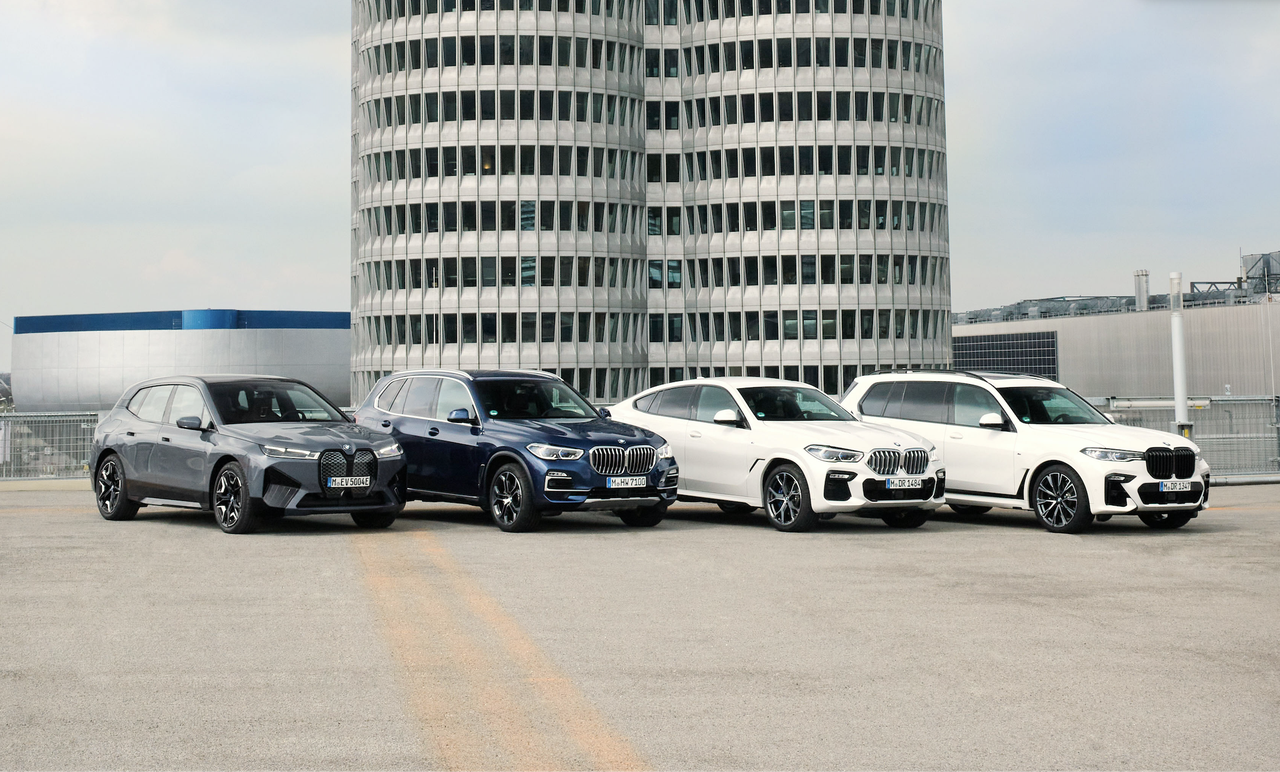
After looking at this picture, most people should already have the answer in their hearts.
Conclusion
The iX is an impressive car, and for traditional car brands, it has been a long time since there has been a car model that makes people feel refreshed from the inside out and has decent product strength.
Yes, the software of the iX is still BMW’s weakness, but the fact that it still has such a large user base indicates that its other charms are still enough to make its target users pay the bill.
At the end of the test drive, before heading to the airport, I opened the iX multimedia list, set the 4D shock to the maximum and the surround effect to the strongest, and played a song called “Wild Heart” by the band Beyond.
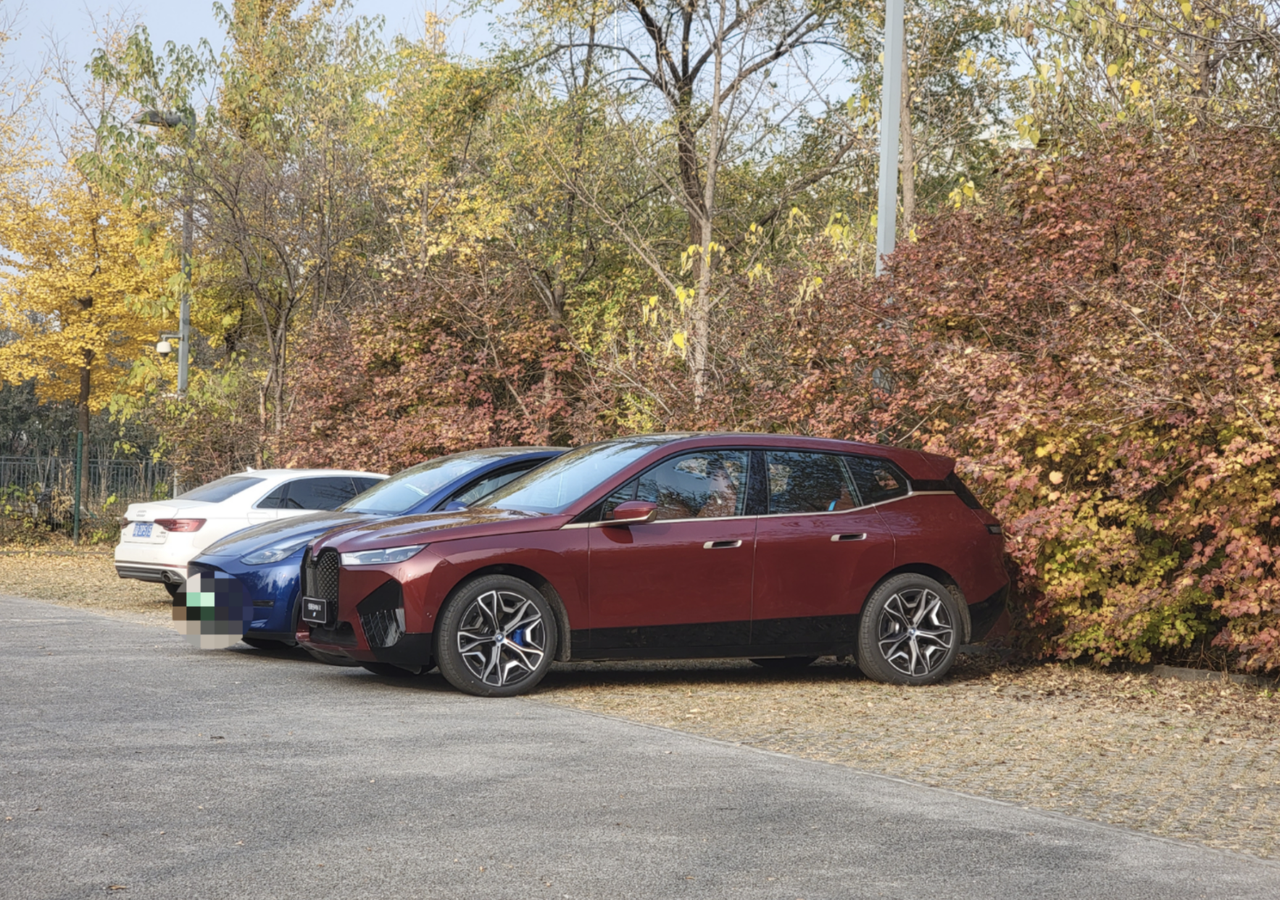
During the playback, a Model Y owner walked around the iX a few times, then stood outside the driver’s window and stared at the central control screen. I don’t know what was going on in his mind at that time, but the sense of pleasure from the music and my vanity mixed together had already spread to my mouth. This might be the competition of iX’s products outside of the car.
By the way, I just configured a top-end iX with the same configuration on the BMW UK official website, and the price is 117,045 pounds, which is equivalent to 1.007 million yuan.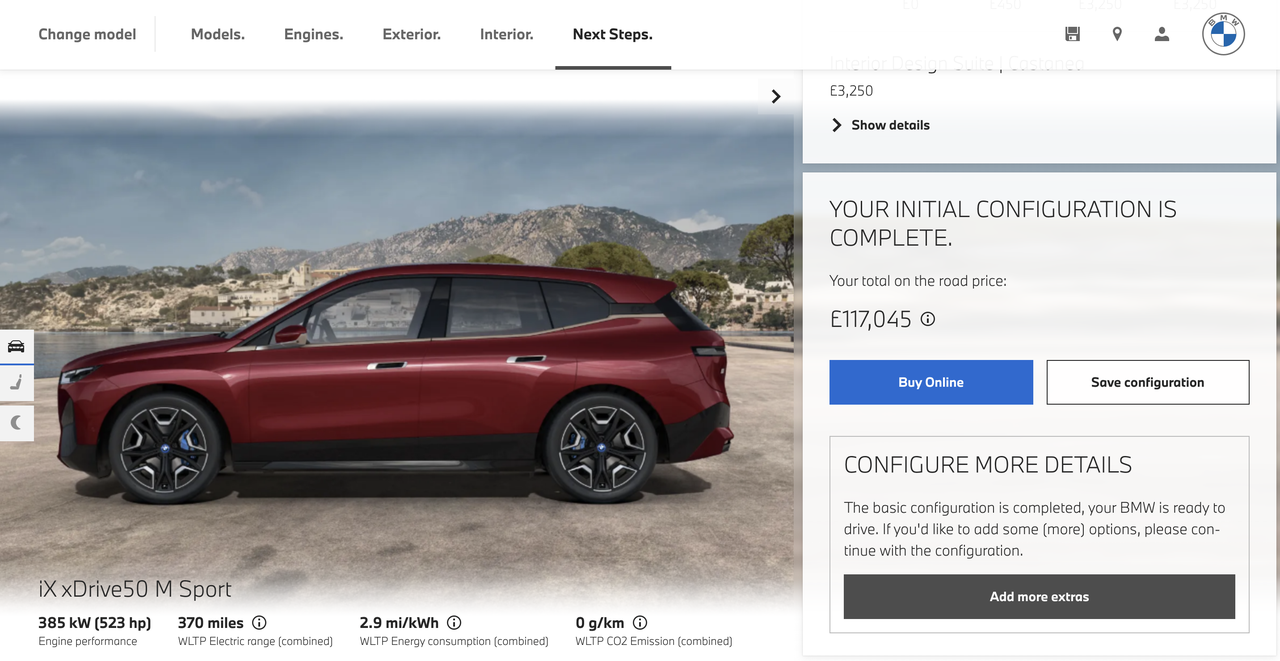
The starting price of Model X Plaid in the UK is €121,990, which is equivalent to RMB 900,000.
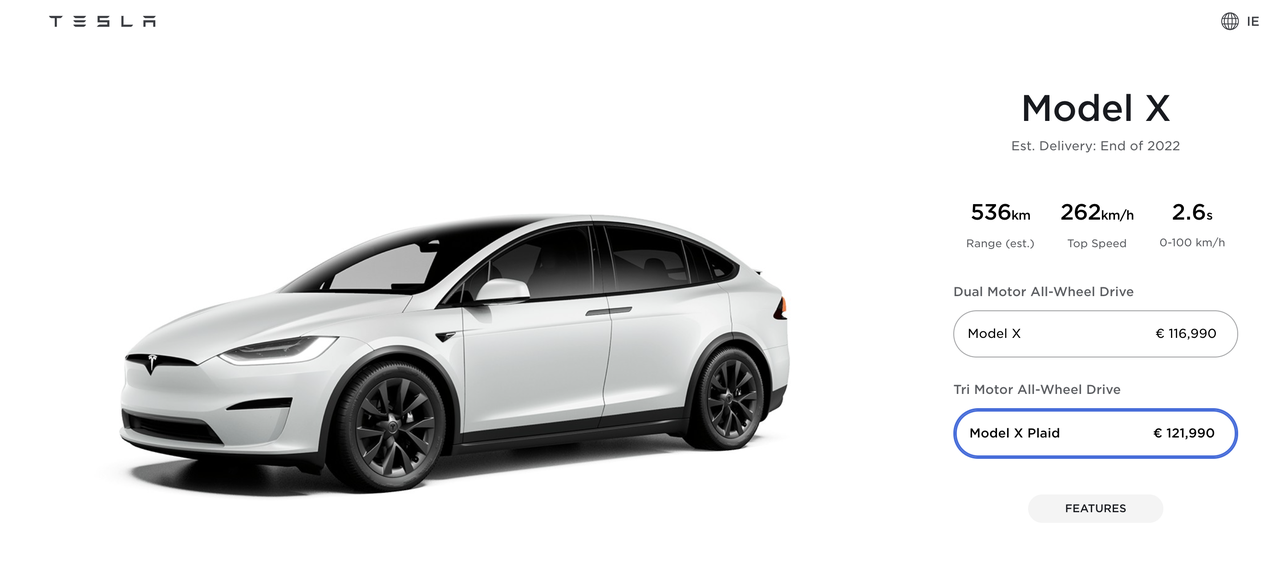
So, this joyful cost may mean giving up a set of optional wheels and interior trim for Model X Plaid in China. As for how many people will make such a decision, we will only know after both cars are delivered.
This article is a translation by ChatGPT of a Chinese report from 42HOW. If you have any questions about it, please email bd@42how.com.
